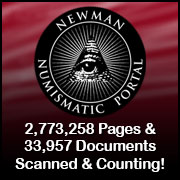
About UsThe Numismatic Bibliomania Society is a non-profit association devoted to the study and enjoyment of numismatic literature. For more information please see our web site at coinbooks.org SubscriptionsThose wishing to become new E-Sylum subscribers (or wishing to Unsubscribe) can go to the following web page link MembershipThere is a membership application available on the web site Membership Application To join, print the application and return it with your check to the address printed on the application. Print/Digital membership is $40 to addresses in the U.S., and $60 elsewhere. A digital-only membership is available for $25. For those without web access, write to: Charles Heck, Treasurer
AsylumFor Asylum mailing address changes and other membership questions, contact Chuck at this email address: treasurer@coinbooks.org SubmissionsTo submit items for publication in The E-Sylum, write to the Editor at this address: whomren@gmail.com BUY THE BOOK BEFORE THE COINSale Calendar
|
- WAYNE'S WORDS: THE E-SYLUM DECEMBER 29, 2019
- NEW BOOK: 100 GREATEST MODERN WORLD COINS
- JOSEPH M. SEGEL (1931-2019)
- 19TH AMENDMENT CENTENNIAL ON NEWMAN PORTAL
- VIDEO: U.S. MINT NEW COINS IN 2019
- NOTES FROM E-SYLUM READERS: DECEMBER 29, 2019
- VOCABULARY TERM: HERALDRY
- GEOFFREY CHARLTON ADAMS (1864-1939)
- SPMC EDUCATIONAL SERIES FORUM AT 2020 F.U.N.
- TUCKER TO SPEAK ON MODERN U.S. MINT MEDALS
- PEI HOLEY DOLLARS TO HIGHLIGHT REGINA SHOW
- UNINTENTIONAL WAYS COLLECTORS DAMAGE COINS
- SHIPPING THEFT LESSONS FOR NUMISMATISTS
- A HISTORY OF MORMON MONEY
- HERITAGE NYINC 2020 SALE HIGHLIGHTS
- KüNKER'S ELIVE PREMIUM AUCTION 332
- NUMISMATIC NUGGETS: DECEMBER 29, 2019
- ANCIENT COIN SERIES: RAVENNA
- AGHLABID DYNASTY GOLD DINARS FOUND IN ISRAEL
- 18TH CENTURY COIN HOARD FOUND IN KRAKOW, POLAND
- THE DECADE AND DECIMALISATION
- 1945 SILVER THREEPENCE SURFACES
- ALCOHOL-FUELED CAR MEDALS OF 1901-1902
- COMPANY SCRIP
- THE HISTORY OF OF HONG KONG BANKS
- BRITISH MUSEUM ACQUIRES 1,000-YEAR-OLD SEAL
- BBC ON THE ORIGINS OF THE DOLLAR SIGN
- THE INCREDIBLE SHRINKING WALLET
- LOOSE CHANGE: DECEMBER 29, 2019
- BANK ROBBER TURNED SANTA
Click here to access the complete archive
Click here to unsubscribe (scroll down)
To comment or submit articles, reply to whomren@gmail.com
Content presented in The E-Sylum is not necessarily researched or independently fact-checked, and views expressed do not necessarily represent those of the Numismatic Bibliomania Society.
WAYNE'S WORDS: THE E-SYLUM DECEMBER 29, 2019
 We have no new subscribers this week. Thank you for reading The E-Sylum. If you enjoy it, please send me the email addresses of friends you think may enjoy it as
well and I'll send them a subscription (but let me know if they are located in the European Union). Contact me at whomren@gmail.com
anytime regarding your subscription, or questions, comments or suggestions about our content.
We have no new subscribers this week. Thank you for reading The E-Sylum. If you enjoy it, please send me the email addresses of friends you think may enjoy it as
well and I'll send them a subscription (but let me know if they are located in the European Union). Contact me at whomren@gmail.com
anytime regarding your subscription, or questions, comments or suggestions about our content.
NBS Members: It's that time of year again - please renew your membership by check or online with Paypal. For more information, see:
https://www.coinbooks.org/about/
membership.html
This week we open with one new book, an obituary, updates from the Newman Numismatic Portal, and notes from E-Sylum readers.
Other topics this week include modern world coins, the Susan B. Anthony dollar, heraldry, dealer Geoffrey Charlton Adams, educational forums, holey dollars, good advice for collectors, auction highlights, company scrip, and the incredible shrinking wallet.
To learn more about nineteenth-century engravers Pierre-Simon-Benjamin Duvivier and William Wyon, Franklin Mint founder Joe Segel, dealer Mike Kliman, tinctures, blazoning, dexter and sinister, antebellum bank note fraud, U.S. Mint silver and gold medals, Mormon money, the Elizabeth I Gold Ship Ryal, the "Three Graces" crown, city gate tokens, Nobel Nominating Committee medals, alcohol-fueled automobile medals, the bank-robber-turned-Santa, and 2x2s of doom, read on. Have a great week, everyone!
Wayne Homren
Editor, The E-Sylum
NEW BOOK: 100 GREATEST MODERN WORLD COINS
Whitman has published a new book written by our friends at CoinWeek, Charles Morgan and Hubert Walker. Congratulations! Here's the press release. -Editor
 Whitman Publishing announces the upcoming release of a new book, 100 Greatest Modern World Coins, by authors Charles Morgan and Hubert Walker. The 168-page
hardcover coffee-table book will debut in March 2020. Before then it can be pre-ordered online (including at Whitman.com) and from booksellers and hobby shops nationwide for
$29.95.
Whitman Publishing announces the upcoming release of a new book, 100 Greatest Modern World Coins, by authors Charles Morgan and Hubert Walker. The 168-page
hardcover coffee-table book will debut in March 2020. Before then it can be pre-ordered online (including at Whitman.com) and from booksellers and hobby shops nationwide for
$29.95.
In this beautifully illustrated book, award-winning numismatic writers Morgan and Walker offer a guided tour of coins that have influenced the world and captured the imaginations of collectors since the early 1900s. Their exploration focuses on such factors as rarity, value, popularity, beauty, innovation, and historical significance.
"We start with the year 1901," the authors said. "The twentieth century was such a consequential period for numismatics that its coins deserve to be considered among their peers. This is an essential period to study in order to understand the present and future role of coins in society. Over the course of 100 coins, we embark on an effort to tell that story."
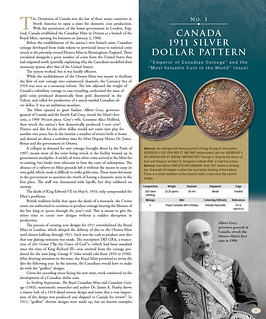

In the book's foreword, Donald Scarinci, ranking member of the U.S. Treasury's Citizens Coinage Advisory Committee, noted that modern coins bridge "the classic designs of the great eighteenth- and nineteenth-century engravers, like Pierre-Simon-Benjamin Duvivier and William Wyon, and the contemporary masterpieces of sculptors such as Herbert Wähner and Donald N. Everhart Jr." He praised Morgan and Walker for setting each coin in context and bringing them to life. "100 Greatest Modern World Coins will inspire, inform, and entertain you," Scarinci said. "Enjoy the journey and let it spark ideas for building your own significant collection."
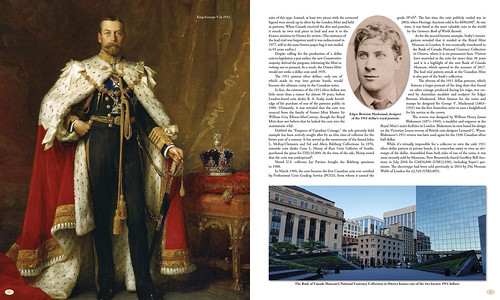
100 Greatest Modern Coins is coffee-table-size, published in full color, with related historical images and stories for every coin. It also includes perspective on market values, field populations, certified coins, quantities minted, specifications, auctions and private sales, museum holdings, coin artists, and more.
100 Greatest Modern World Coins
By Charles Morgan and Hubert Walker; foreword by Donald Scarinci
ISBN 0794846335; hardcover, coffee-table (10 x 12 inches); 168 pages; full color; retail $29.95 U.S.
ABOUT THE AUTHORS
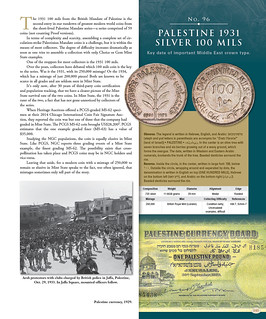 Charles Morgan is an award-winning numismatic writer, industry analyst, and editor of one of the hobby's most visited online publications, CoinWeek.com. At
CoinWeek, he has written about and covered the entire gamut of numismatic topics. As the host of the CoinWeek Podcast, Morgan has dug deeper into the history of
numismatics with some of the hobby's leading personalities.
Charles Morgan is an award-winning numismatic writer, industry analyst, and editor of one of the hobby's most visited online publications, CoinWeek.com. At
CoinWeek, he has written about and covered the entire gamut of numismatic topics. As the host of the CoinWeek Podcast, Morgan has dug deeper into the history of
numismatics with some of the hobby's leading personalities.
His main areas of collecting interest are numismatic literature and the coins and medals of the Food and Agriculture Organization (FAO) of the United Nations. He also collects U.S. coins, classic films, and comic books.
Morgan studied English at Susquehanna University and the University of Virginia and served in the U.S. Army as a Russian linguist. He lives in Virginia with his wife, two children, and a very temperamental Maine Coon cat.
Hubert Walker is the assistant editor of CoinWeek.com and along with Charles has written numerous award-winning articles and columns, both online and in print. He studied English at the University of Virginia, though he is also keen on history, music, and art. Hubert currently resides in Virginia; his cat does not.

JOSEPH M. SEGEL (1931-2019)
Serial entrepreneur and Franklin Mint founder Joe Segel has passed. Here's an excerpt from a Philadelphia Enquirer article published December 22, 2019. -Editor
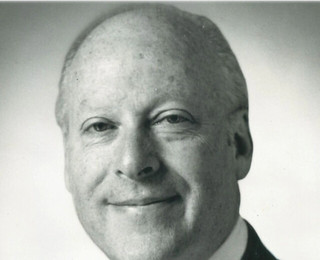 Joseph M. Segel, 88, a prolific entrepreneur who founded home-shopping network QVC and collectibles maker Franklin Mint, along with nearly two dozen other businesses,
died Saturday in Gladwyne of congestive heart failure.
Joseph M. Segel, 88, a prolific entrepreneur who founded home-shopping network QVC and collectibles maker Franklin Mint, along with nearly two dozen other businesses,
died Saturday in Gladwyne of congestive heart failure.
Mr. Segel started his first business at age 12, ran four before he graduated college, and never stopped trying new ideas even if his concepts sometimes failed. He was most successful in publishing, marketing, and minting, but he also created photography, aviation, and software companies, and he turned an old retirement home into a top-rated luxury hotel in the Swiss Alps. His most recent business venture, HairRx, a hair care system, was launched in 2018.
"He was universally admired and respected in every industry he touched," his son Alan said. "He only left a trail of happiness, wealth and success for others. That's his legacy."
Mr. Segel was born and raised in West Philadelphia, the oldest of Albert and Fannie Segel's two children. His father was a partner at a small real estate firm, his mother an active figure in the community.
After his 1947 high school graduation, Mr. Segel enrolled at the University of Pennsylvania. But he kept up with his businesses, developing a personalized desk sign business and then the Advertising Specialty Institute, a trade association of sorts that also printed a directory of advertisers.
After graduating from Penn in 1951 with a bachelor of science degree, Mr. Segel enrolled at the Wharton School to get an MBA but, according to Alan Segel, he was too distracted with his business endeavors to focus on class. He dropped out, a decision that certainly didn't impede his future success.
A year after marrying his second wife, Doris Greenstein in 1964 (Renee was his first wife), Mr. Segel saw pictures of people lined up around the Treasury Department to buy the last silver dollars minted by the U.S. government. That would inspire a new business venture. The National Commemorative Society made and sold sterling silver commemorative medals honoring American history events and people. The first medal commemorated five-star Army Gen. Douglas MacArthur.
But Mr. Segel was disappointed with the quality of work from his subcontractor. So, he created his production company for coins and other collectibles, General Numismatics Corp., which later became the Franklin Mint, which was based in Wawa, Delaware County, and was listed on the New York Stock Exchange. The brand name is currently owned by New York-based Sequential Brands Group.
"QVC was his biggest accomplishment but his pride was Franklin Mint because Franklin Mint was so his baby. He built it from zero," Alan Segel said. "Franklin Mint started with making a few coins literally and he bought a few presses and he minted coins and he looked for a better way to do it. … It evolved totally from the seed of his creative mind and it became quite large, a publicly traded, largest private mint in the world at one point."
Mr. Segel's travels around the world on behalf of Franklin Mint and as a member of the U.S. delegation to the United Nations General Assembly spurred two other businesses: one successful, the other not so much.
Mr. Segel attempted to retire in 1983 after developing a PC software testing business, which was subsequently bought by McGraw-Hill. Restless by 1986, he decided to improve upon the Florida-based Home Shopping Network by shipping products within days instead of weeks and disclosing shipping fees up-front. He called the new business QVC Network, the initials for Quality Value Convenience.
He recruited several of the vice presidents he had hired at Franklin Mint to help launch and later manage QVC, based in West Chester. The channel now reaches more than 23 million customers worldwide and is one of the largest e-commerce companies in the world.
Mr. Segel retired as chairman of QVC in 1993 but continued to serve as an executive consultant to management for another 20 years.
At the time of his death, Mr. Segel was in hospice care at Waverly Heights.
To read the complete article, see:
Joseph M. Segel, 88, founder of QVC and Franklin Mint, dies
(https://www.inquirer.com/obituaries/joseph-segel-qvc-franklin-mint-philadelphia-obituary-20191222.html)
For much more information on Mr. Segel and the Franklin Mint, see the earlier E-Sylum articles, linked below. -Editor
To read earlier E-Sylum articles, see:
INTERVIEWS WITH JOE SEGEL AND CHARLES ANDES OF THE FRANKLIN MINT (https://www.coinbooks.org/esylum_v11n08a21.html)
MORE ON FRANKLINIUM (https://www.coinbooks.org/esylum_v16n13a25.html)
A SHORT HISTORY OF THE FRANKLIN MINT (https://www.coinbooks.org/esylum_v18n13a14.html)
DAVID GANZ ON FRANKLIN MINT FOUNDER JOSEPH SEGEL (https://www.coinbooks.org/esylum_v18n14a06.html)
THE RISE AND FALL OF THE FRANKLIN MINT (https://www.coinbooks.org/esylum_v19n01a20.html)
MORE ON JULIAN'S MEDALS OF THE U.S. MINT (https://www.coinbooks.org/v20/esylum_v20n02a11.html)

19TH AMENDMENT CENTENNIAL ON NEWMAN PORTAL
The latest addition to the Newman Numismatic Portal is a group of U.S. Mint marketing material for the Susan B. Anthony dollar. Project Coordinator Len Augsburger provided the following report. -Editor
The 19th Amendment Centennial
 The 19th amendment, allowing women the right to vote, was passed in 1920. The Harriett Tubman U.S. $20 note, intended for production in 2020, partly in honor of the 19th
amendment centennial, was delayed by the Trump administration in June, 2019, with the stated reason being the unavailability of new security features. The 19th amendment also
played a role in the marketing of the Susan B. Anthony (SBA) dollar in 1979.
The 19th amendment, allowing women the right to vote, was passed in 1920. The Harriett Tubman U.S. $20 note, intended for production in 2020, partly in honor of the 19th
amendment centennial, was delayed by the Trump administration in June, 2019, with the stated reason being the unavailability of new security features. The 19th amendment also
played a role in the marketing of the Susan B. Anthony (SBA) dollar in 1979.
Recently scanned by John Graffeo at the National Archives in Denver, Newman Portal includes a package of SBA dollar marketing information aimed at bankers and retailers. Benefits of the coin were said to be easier counting, reduced errors in counting, faster retail transactions, and "enhanced practicality of the $2 note."
The Treasury further offered retailers promotional ideas for the new coin, such as offering items at special prices "if purchased with at least one Anthony dollar." Biographical material related to Anthony, included in the marketing material, notes her advocacy of the 19th amendment. The failure of the SBA coin is well-known, and the Tubman $20 remains in the planning stages. Here's hoping Treasury can do more in 2020 to recognize the contribution and legacy of all Americans.
Image: Cartoon from Susan B. Anthony dollar marketing material, "Happiness is a dollar that won't blow away."
Link to Susan B. Anthony marketing packet on Newman Portal:
https://nnp.wustl.edu/library/book/545556
VIDEO: U.S. MINT NEW COINS IN 2019
These are selections from the David Lisot Video Library that feature news and personalities from the world of coin collecting. David has been attending coin conventions since
1972 and began videotaping in 1985. The Newman Numismatic Portal now lists all David's videos on their website at:
https://nnp.wustl.edu/library/multimediadetail/522852
Here's one on new coins from the U.S. Mint in 2019. -Editor
 Jill Westeyn, Public Affairs, US Mint, Interviewer, David Lisot, CoinTelevision.com.
Jill Westeyn, Public Affairs, US Mint, Interviewer, David Lisot, CoinTelevision.com.
An excerpt of the video is available for viewing on the Coin Television YouTube Channel at:
https://youtu.be/aMTEz1p7YO0
The US Mint had some new items for sale to collectors. Jill Westeyn, Public Affairs and Social Media Coordinator attended her first American Numismatic Association Convention and talked about the new coins and medals. They include the "Pride of Two Nations", American Liberty Silver High Relief Medal, and the $100 Liberty Gold High Relief.

NOTES FROM E-SYLUM READERS: DECEMBER 29, 2019
Pillory Ferran Fezziwig!
Bill Eckberg is a member of my northern Virginia numismatic social group, Nummis Nova. Now retired and living in Florida, he keeps tabs on us through my Numismatic Diary articles. Last week I recounted events at our annual holiday dinner at Gadsby's tavern in Alexandria, VA. -Editor
Bill writes:
I particularly enjoyed the Nummis Noval report. Gadsby's has long been a favorite. Susan and I had our wedding reception there, though the minstrel didn't come by that night. Did he speak only of 1819? Back in the day, he only knew of current events from exactly 200 years ago. I once attended the Old Presbyterian Meeting House and saw him there in current attire.
I must take exception to the report by Ferran Fezziwig. My proof 1895 dollar was NOT returned, and I suspect that he was the true culprit. Please have him pilloried.
To read the earlier E-Sylum article, see:
WAYNE'S NUMISMATIC DIARY: DECEMBER 22, 2019 (https://www.coinbooks.org/v22/esylum_v22n51a20.html)
Mike Kliman - Farouk Sale Attendee
Julian Leidman writes:
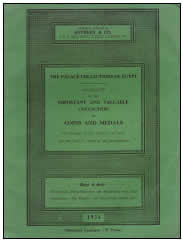 I believe that Mike Kliman, Abe Kosoff's son-in-law and professional numismatist was at the Farouk sale and is still alive, to the best of my knowledge. I do not
know if Mike purchased anything at the sale, as did Storck and the other dealers in attendance at the sale.
I believe that Mike Kliman, Abe Kosoff's son-in-law and professional numismatist was at the Farouk sale and is still alive, to the best of my knowledge. I do not
know if Mike purchased anything at the sale, as did Storck and the other dealers in attendance at the sale.
Thanks, Julian. Kliman would also be about 88 years old. Linked below is a 2009 article where Alan Weinberg recounted a conversation with Kliman about the sale. -Editor
To read the earlier E-Sylum articles, see:
MORE ON THE FAROUK SALE (https://www.coinbooks.org/esylum_v12n07a18.html)
MAURICE A. STORCK SR. (1922-2019) (https://www.coinbooks.org/v22/esylum_v22n51a05.html)
On Selling Medals of Honor
I'm sorry for the delay in publishing this note - it got lost in my inbox for a month. -Editor
Jeffrey S Zarit writes:
I liked your stories on medals of honor. I have understood that the Medal of Honor cannot be bought or sold. I do not know if this is true also for Great Britain's Victoria Cross. In my opinion, all medals, where the recipient places his life in danger, should never be bought or sold, but should remain in the recipent's family, or returned to the issuer.
To read the earlier E-Sylum issue, see:
Volume 22, Number 46, November 17, 2019 (https://www.coinbooks.org/v22/club_nbs_esylum_v22n46.html)
Harvey Stack on Printing Technology
Harvey Stack writes:
I read all of last week's E-Sylum and became intrigued by the story "Hand cut - Hand Engraving " I first learned about printing my early years at Stack's (1947) when we had to write catalogs, send manuscript to the printers, go to the shops that did the work, and thereby be sure that all we printed was mailed out.
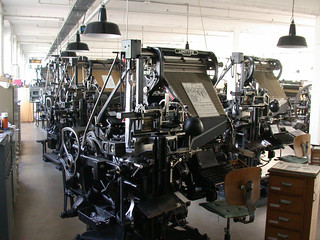 I went to a printing plant in Federalsburg Maryland, J.W. Stowell Printers, and watch how lineotype machines produced copy from magazines filled with type, of different
sizes, usually of one or two type styles per magazine.
I went to a printing plant in Federalsburg Maryland, J.W. Stowell Printers, and watch how lineotype machines produced copy from magazines filled with type, of different
sizes, usually of one or two type styles per magazine.
I saw the "brass" letters drop on a line, forming words, and as each line was complete the lyneotype would slide over to a mold, hot lead would pour into mold, and a line of type was created. Then these lines would be assembled on a tray , spaces inserted between them, and galleys were then produced to be proof read.
Once this was done, blocks of wood, having the photos made in a metal photo shop introduced to the copy, and by hand one of the type setters would create pages for print. Though from above, with the techniques these workmen had, a 50 page catalog, with photos in place, were mounted on 8 page (sometimes larger) frames and were used on the flat-bed press to create a catalog. The whole proccess usually took less than 2 days.
Coincidentally with your story in this week's E-Sylum, is a very detailed article in the Double Issue "Economist" dated December 21. 2019, entitled "THE AGE OF MECHANICAL REPRODUCTION AS A WORK OF ART " starting on page 22 of this issue.
It reviews the early history of die cut hand leadering from the early days from early ancient times to the 20th Century. The early use of wood-faced letters, than hand cut metal, and the use of thousands of different Fonts and Sizes is very instructive for those who like the study the advent and use of printing to record history, and tell stories., write scientific books as well as novels. History would have been lost if this science and art was not developed.
I couldn't find the Economist article online - it's probably behind a firewall. Thanks, Harvey, for bringing this to our attention. The technology sure has changed over the last couple decades. -Editor
To read the earlier E-Sylum article, see:
VOCABULARY TERM: HANDCUT, HAND ENGRAVING (https://www.coinbooks.org/v22/esylum_v22n51a11.html)

VOCABULARY TERM: HERALDRY
Dick Johnson submitted this entry from his Encyclopedia of Coin and Medal Terminology. Thanks. -Editor
Heraldry. The creation and description of coats of arms, mostly inherited, which traces its origin to the symbols used on shields, banners and cloaks of armored knights of the Middle Ages. Heraldry is very important to numismatics because of its influence in symbolism and the widespread use of coats of arms that appear on coins and medals. These arms have been established for countries, states, provinces, municipalities, corporations, firms, families, universities, church organizations, other institutions and organizations.
Heraldry is very symbolic. It has a technical language all its own and prescribed rules for designing and describing the coats of arms. While it has little formal standing in the United States, Americans still use heraldry for a number of national symbols, seals, logos and trademarks – including our national shield, "Stars and Bars." The military utilizes heraldic symbolism extensively, for insignia, emblems, badges, patches, and uniforms. The Department of Defense maintains an institute of heraldry to design and coordinate all such symbolic use.
Heraldry is far more accepted, respected and has legal statues in Europe, especially Great Britain. The institution in control of heraldry there is the Royal College of Heralds which is the arbitrator of correct heraldry symbolism and use in the English language. It also presides over armorial rights and maintains a large collection of records.
Blazoning. Heraldry symbols – primarily coats of arms – have been used for devices of coins and medals for many countries and other issuing authorities. Such armorial designs are described and cataloged in numismatic literature, the act of heraldic describing – called blazoning – requires knowledge of heraldic rules and the subject's own technical language.
Heraldic terms are mostly of French origin (from Norman French of Middle Ages) but are pronounced as English. While easy to pronounce they are sometimes difficult to comprehend. For example, right and left are dexter and sinister. But heraldry rules require this to be the shield's right and left in opposition to the viewer's fright and left as in all other numismatic describing.
Heraldic coats of arms often become an entity's modern trademark, logo, seal or symbol. Philip Morris Company, for example, has an elaborate coat of arms as its trademark. The symbol of a snake and eagle, long used in Mexican coin design, is taken from Mexico's coat of arms.
Blazoning is – like numismatic describing – a formal wording for a coat of arms design. In addition to a broad and colorful language it also has prescribed rules for all descriptions. Adjectives are always placed after their nouns. Lion gules is red lion. The elements of an elaborate coat of arms are blazoned in precise sequence and form.
Some heraldic terms are the same as those in numismatics. These include field, crest, engrailed, escutcheon, bar, cross, lozenge, couped, erased, banderole, canton, regardant, among others. In fact, heraldic terms were the source of many numismatic descriptive terms.
Beasts real and imagined. There are numerous beasts in heraldry, any one or two of which may appear on a coat of arms. These include mythical, imaginary, symbolic and mystical beasts, in addition to realistic animals, birds, fish and insects. They are often combined with parts of man to give them an anthropomorphic attribute. These need to be correctly identified in all numismatic description.
Shields. Forms and shapes of the shield are important, as well as sectioning (the dividing of a shield in halves, or quarters to reflect four predecessors, say, or the merging of four families, or a quartet of other design influences). The designs on a shield are called charges (on a coin or medal such a design would be the device).
Color is added by what is called tinctures. Unless a medallic item is enamelled, color is indicated on coins and medals by a code of shading (similar to that devised by print engravers several centuries ago). Thus horizontal lines indicate blue (azure), vertical lines mean red (gules), descending diagonal means green (vert), ascending diagonal is purple (purpure) and crosshatch is black (sable). Also a repeated small dot pattern indicates gold (or) and no shading or texture means silver (argent).
Like the knights' cloaks, the shields were infrequently embellished with furs. This presented another problem for engravers who solved it by limiting the symbolism of furs to black tails and white (ermine) tails. Often this was in contrast to the tincture of the shield.
Other design elements. Coat of arms were often surmounted with crowns (in heraldry called coronets). Each rank of nobility had a coronet of distinct design. A duke's crown was ornamented with strawberry leaves, a marquess with alternating strawberry leaves and balls, a viscount with nine balls, an earl with five balls, a baron with four balls.
Ribbons and banners are prominent in heraldic design, often with an inscription or motto appearing as a single line occupying the narrow ribbon. Lettering was limited somewhat to what would fit on a flowing ribbon. Language was most often Latin. Heraldic ribbons and scrolls are called banderoles and listons.
In creating a numismatic or medallic design which includes a coat of arms great care must be taken to insure absolute accuracy. The artist must understand the symbolism and faithfully execute an existing heraldry design.
Describing numismatic items. A numismatic description is not complete until it fully describes every coat of arms or other heraldic design. It is the cataloger's option whether to use plain English in describing (as the viewer's right and left) or blazoned version (dexter and sinister), or both (making sure the reader understands).
Because coin designs are so small, and somewhat true or medals, the heraldic design may be meager. It is the cataloger's chore to decipher the lines irrespective of how crude or tiny (or obscure) the engraving may appear on the coin or medal.
Thus in describing numismatic items with coats of arms it is often useful to do so with a heraldry reference book at hand. The heraldic terms listed here and the adjacent chart, the more notable ones used in numismatics, are only a small portion of the total heraldic technical language.
References:
H1 {1840} Berry.
H2 {1889} Elvin.
H3 {1895} Zieber.
H4 {1945} Butler.
H5 {1979} Pastoureau.
Heraldry Terms Frequently Used In Describing Coins and Medals
It's too lengthy to republish here, but scroll to the end of the dictionary entry on the Newman Numismatic Portal for Dick's great list of Heraldry Terms Frequently Used In Describing Coins and Medals. -Editor
To read the complete article, see:
Heraldry (https://nnp.wustl.edu/library/dictionarydetail/516048)
Looking for the meaning of a numismatic word, or the description of a term? Try the Newman Numismatic Portal's Numismatic Dictionary at: https://nnp.wustl.edu/library/dictionary
Or if you would like a printed copy of the complete Encyclopedia, it is available. There are 1,854 terms, on 678 pages, in The Encyclopedia of Coin and Medal Technology. Even running two a week would require more than 19 years to publish them all. If you would like an advance draft of this vital reference work it may be obtained from the author for your check of $50 sent postpaid. Dick Johnson, 139 Thompson Drive, Torrington, CT 06790.

GEOFFREY CHARLTON ADAMS (1864-1939)
Adams, "Geoffrey Charlton" (1864-1939), born May 11, at Covington, Kentucky. His parents are listed in the 1910 U. S. Census as natives of Kentucky. However, very curiously in the 1930 Census they are listed as Scottish born in Scotland. This bogus genealogy continued where his father was Warren Adams and his mother was a McGregor also from Scotland listed on his funeral home death certificate with the information supplied by his third wife Marion J. Adams who survived him. However, we know that is false. He married his third wife Marion J. Adams in 1915, which is when he began telling his third wife he was Scottish descent. Maybe she was Scottish and he was trying to impress her. We give you this up front since he is one of the most enigmatic, difficult and elusive numismatic biographies ever to trace out.
Adams claimed to be a numismatist since 1879. The only records known that can place him as a numismatist in the 19th century are those found in the Lupia Numismatic Library, Special Collection, the Chapman Family Correspondence Archive.
On February 26, 1894, he was married to Henrietta "Ettie" Wing Dorr of Buffalo, New York, at Church St. John the Evangelist, Boston, Massachusetts. So we know he was always on the go as a traveling salesman of some sort. Regardless, the marriage was brief for he marries a second time four years later.
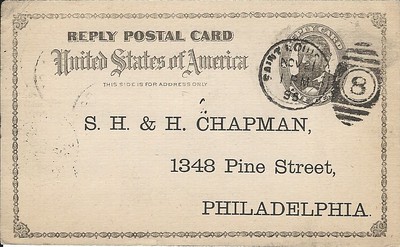
Fig. 1. Postal Card sent by G. C. "Geoffrey Charlton" Adams to the Chapman Brothers postmarked Saint Louis, Missouri, November 21, 1895 at 1 P.M. This is very possibly the Chapman reply card mailed with their circular about the Richard Boswell Winsor sale held on December 16-17, 1895 that was mailed to Frank Elmer Ellis the owner of St. Louis Stamp and Coin at Saint Louis, Missouri. If so Ellis gave the card to Adams to solicit a copy of the Winsor catalogue as a courtesy to a customer. Courtesy, Lupia Numismatic Library, Special Collection, the Chapman Family Correspondence Archive.
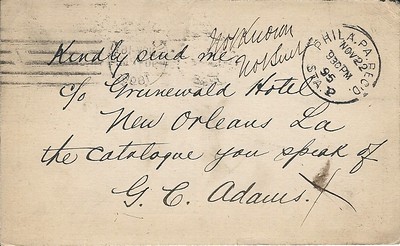
Fig. 2. Verso of the Postal card "Kindly send me c/o Grunewald Hotel, New Orleans, La., the catalogue you speak of. G. C. Adams." The Chapmans annotated: "Not known Not sent" Apparently Adams was not entered in their clientele list betraying the fact that the reply card was given to him by one of their clients in St. Louis. Since the card was postmarked "Saint Louis, MO" and the request to send a catalogue to New Orleans, Louisiana must have sounded suspect to the penny-pinching Chapmans who were far too reticent to send off a catalogue at their expense with no guarantee of a return.
There are currently 17 pieces of correspondence from Geoffrey Charlton Adams catalogued in the Lupia Numismatic Library.
The Grunewald Hotel was a newly built hotel in 1893 by Louis Grunewald (later renamed the Roosevelt Hotel). Adams was apparently a traveling salesman or traveling engineer consultant as he avers in his publications.
As John Weston Adams (no relation) points out Geoffrey Charlton Adams emerged as a coin dealer out of the blue in 1903. At that time he resided at Creston Avenue, Bedford Park, New York City, New York, and later kept an office in 1905 at 608 Flat Iron Building, New York City, New York Coin. He was not only a coin dealer but in 1905 the owner-editor of The Coin Cabinet, and publisher of thirty coin auction catalogs from May 1903 to October 1906 as a numismatic cataloguer and auctioneer. He was also a book auctioneer of both numismatic literature and rare books. (New York, 1903-1906). In January 1904 he advertised a book auction in the New York Times.
He is well-noted for his September 2, 1904 paper delivered to the Chicago Numismatic Society with his critique of the 1804 Silver Dollar as a later restrike based on his opinion as an engineer that these coins were all later struck with a steam press engine between 1836 to 1860 and postulating they all date to the latter. Early in 1906 he donated numismatic literature to the ANS Library. At the March 15th, 1906 meeting of the Royal Numismatic Society, London, which he attended, he was elected a Fellow member to the RNS.
Farran Zerbe wrote a complimentary piece about Adams in The Numismatist, August, (1906) : 272. The Numismatist, October 1906 issue, page 344 lists him as expelled from the ANA. There is no record held by the ANA explaining why Adams was expelled. In the June–July 1907 issue, The Elder Monthly, reprints an obviously fictitious and vituperative letter from "A Reader," titled "Where is Geoffrey" and reading in part: "Have any of your readers seen or heard of Geoffrey ‘Charlatan' [Charlton Adams], member R.N.S., etc., etc., etc.? he who formerly held a ‘suite' in the famous ‘Scrapiron." The accusation of his being a Charlatan, i.e., an impostor suggests he used either a fictitious name or assumed the identity of someone else. A decade later Thomas Lindsay Elder capitalized on this silent mystery making acid comments about him in one of his catalogues implying he either absconded with several collectors coins or their money. Was Elder telling the truth or just being Elder the infamous rival of Farran Zerbe?
At the October 1909 meeting of the Royal Numismatic Society, London, he was removed as a member for non payment of dues having been in arrears for two years. In 1910 he resided in Riverside, Bergen County, New Jersey, with his second wife and in-laws Walter F. and Anna Macy, married to their daughter Letitia (1874-1968). That 1910 Census says they were married for 12 years making the wedding take place in 1898. He is listed as an engineer but accordingly never attended school. Hence contradictions about him abound.
In 1915 he married Marion J. Adams (1895-). In 1930 he was in New Orleans, Louisiana working as a Civil Engineer Consultant. He and his wife Marion moved to San Francisco, California in 1933, residing at 2360 Mission Street. On May 23, 1939 he died in San Francisco Hospital, San Francisco, California.
Adams was a member of the Nantucket Historical Society and Royal Numismatic Society while married to his second wife.
To read the complete article, see:
ADAMS, GEOFFREY CHARLTON
(https://sites.google.com/a/numismaticmall.com/www/numismaticmall-com/adams-geoffrey-charlton)
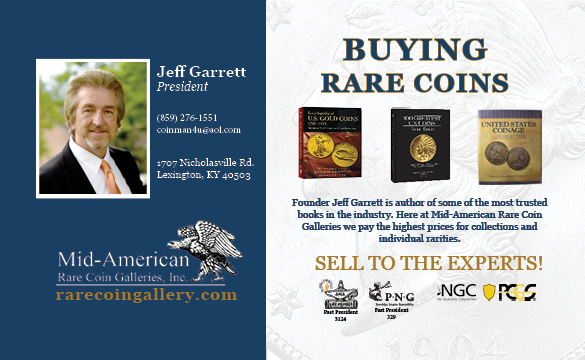
SPMC EDUCATIONAL SERIES FORUM AT 2020 F.U.N.
Several talks are scheduled for the Society of Paper Money Collectors Educational Series Forum at the upcoming F.U.N. show. -Editor
Florida United Numismatists (FUN) Convention, Orlando, Florida,
January 10-11, 2020
Orange County Convention Center, West Building WA1 & WA2
9800 International Dr.Orlando , FL 32819

Friday – January 10 – All Seminars in Room W304F
8:00am
Robert Calderman, "The Current Status of the U. S. Small Size Paper Money Market"
Mr. Calderman, a specialist and dealer in U. S. small-size type notes will discuss the current trends in small size notes and the future of this paper money specialty.
9:30am
Dustin Johnston, "A Behind the Scenes Look at the Paper Money Auction Process"
Mr. Johnston, the Vice-President and Managing Director of the Currency Division at Heritage Auctions will discuss the nuts-and-bolts of conducting a major Paper Money auction.
11:00am
Pierre Fricke, "An Overview of the Confederate Paper Money Market" - Educational Seminar
Mr. Fricke has been a long-time dealer in Confederate Paper Money and is the author of the standard reference on Confederate Paper Money "Collecting Confederate Paper Money: The Standard Guide to Confederate Money".
12:30pm
Wendell Wolka, "The good, the bad, and the ugly of antebellum bank note fraud"
Various types of pre-Civil War bank note fraud will be explored and illustrated.
Saturday – January 11 – Room W303B
8:30am - SPMC Membership Meeting
Mark Drengson, "Overview of the SPMC Bank Note History Project"
This project is focused on two of the primary historical aspects of the "Hometown" National Bank Notes - the Banks who issued them and the bankers who signed them
For more information on the Society of Paper Money Collectors, see:
https://www.spmc.org/
TUCKER TO SPEAK ON MODERN U.S. MINT MEDALS
Dennis Tucker of Whitman Publishing will speak at the Atlanta ANA National Money Show in February. -Editor
 Dennis Tucker, author of American Gold and Silver: U.S. Mint Collector and Investor Coins and Medals, Bicentennial to Date, will give a program on "Collecting Modern
U.S. Mint Silver and Gold Medals for Fun and Profit" at the American Numismatic Association's National Money Show on February 27, 2020, in Atlanta.
Dennis Tucker, author of American Gold and Silver: U.S. Mint Collector and Investor Coins and Medals, Bicentennial to Date, will give a program on "Collecting Modern
U.S. Mint Silver and Gold Medals for Fun and Profit" at the American Numismatic Association's National Money Show on February 27, 2020, in Atlanta.
The United States Mint has produced dozens of silver and gold medals since the national Bicentennial in 1976. They include some of the most beautiful collectibles ever designed and engraved to represent the United States. Some have been runaway best-sellers, and some have even made national headlines. Many are sought by collectors around the globe. Some are "sleepers"—underappreciated treasures with great potential waiting to be discovered. Tucker illustrates these medals and looks at new and upcoming programs in a colorful presentation.
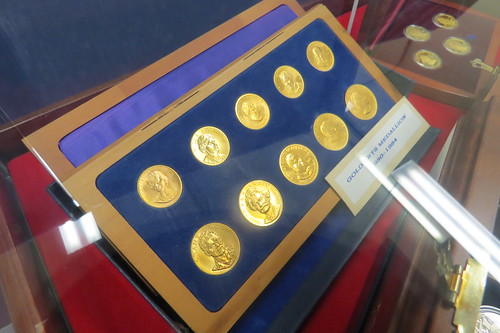
American Arts Gold Medallions on display at the West Point Mint. (Photo courtesy of Dennis Tucker.)
The presentation, part of the ANA's "Money Talks" program, will be given at the Cobb Galleria Centre in Atlanta, Thursday, February 27, 2020, at 10:00 a.m.
Tucker is an award-winning author, a life member of the ANA, and a past governor of the Token and Medal Society. He serves the hobby as publisher of Whitman Publishing and numismatic specialist of the Treasury Department's Citizens Coinage Advisory Committee.

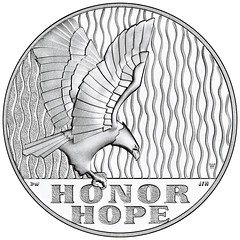
In 2011 silver medals were struck in Philadelphia and West Point to remember the heroes of 9/11.
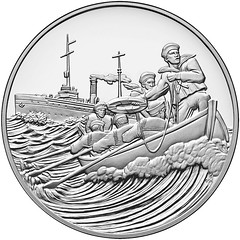
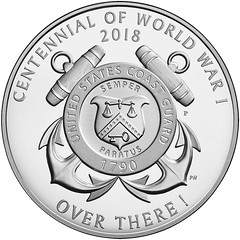
Fewer than 10,000 of the Mint's World War I Centennial silver medals for the U.S. Coast Guard were minted and sold. Yet the Coast Guard has 42,000 active-duty members, 7,500 reservists, and 30,000 auxiliary members. Will this medal become a valuable rarity?

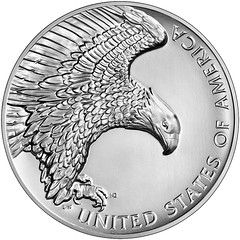
Recent high-relief .999 fine silver medals show modern allegories of American Liberty.

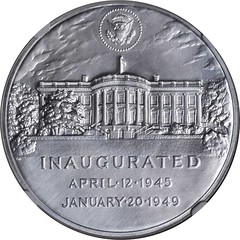
The Mint has reissued several historical Presidential medals in fine silver in recent years. (Photos courtesy of Stack's Bowers Galleries.)
The U.S. Mint has produced quite a number of high-quality medals in recent years. Many may be overlooked in the market today, but future generations of collectors will enjoy them. This may be a great time to acquire some. -Editor
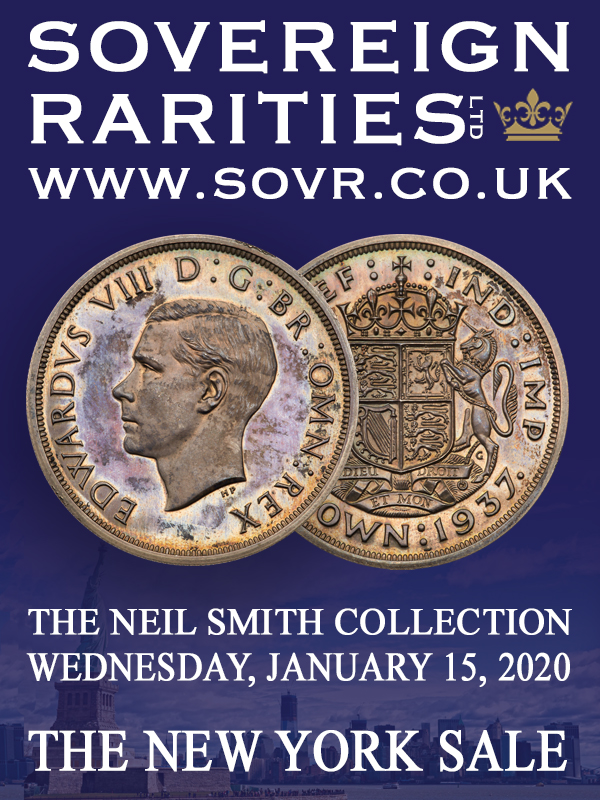
PEI HOLEY DOLLARS TO HIGHLIGHT REGINA SHOW
George Manz submitted this information about a great exhibit at the April 2020 Regina, Canada Coin Club show -Editor


Three rare pierced and counterstamped Holey Dollars from Prince Edward Island will be on display at the Regina Coin Club Spring 2020 Show and Sale.
In 1813, soon after the arrival of Lieutenant Governor Charles Douglas Smith to PEI, he announced that because of the shortage of coinage on the island, a new coinage would be introduced. And what a coinage it was.
Because most of the merchants on PEI had to import their goods for sale from either Great Britain or Halifax, Nova Scotia, the merchants hoarded any coinage that came their way. So it was difficult to make transactions with no money readily available.
So Smith decided to import 1,000 Spanish-American 8 reales coins, and pierce the centre of each, thereby producing two tokens: the centre or plug would be worth one shilling, while the ring or Holey Dollar would be worth five shillings. Because the 8 reales coin was worth five shillings throughout the British Empire, the two new tokens would be worth 20 percent more on PEI than in a different jurisdiction.
Each Holey Dollar and plug was counterstamped with a mark of ten triangles resembling a star. Smith then issued a proclamation to the effect on September 24, 1813, which reads in part: "It is also ordered that Spanish Dollars, limited to the amount of One Thousand, shall be cut at the Treasury, by having a circular piece taken out of the centre of each – the Dollars so cut, are to be issued from and received at the Treasury at the rate of Five Shillings Currency each, and the piece so taken out to be issued from and received at the Treasury at one shilling currency each."
Christopher Faulkner's wonderful book The Holey Dollars and Dumps of Prince Edward Island was published by Spink in 2012. Faulkner's book describes in detail how and why they were produced and lists 79 Holey Dollars that were then known to exist. Eight years after publication, another four have turned up, making a grand total of 83 Holey Dollars.
The three Holey Dollars on display in Regina include the Hill Dollar, the Foster Dollar and the Norweb Dollar.
The Hill Dollar was minted in Mexico City in 1808 during the reign of Charles IV of Spain. It is named after one of its former owners: Leslie Hill of British Columbia, a long-time coin collector, coin dealer and author.
The Foster Dollar was minted in Mexico City in 1805 during the reign of Charles IV of Spain. It is named after Joseph C. Foster of Virginia, USA. Other notable owners of the dollar include Douglas Robins whose massive token collection was recently sold at auction and long-time collector and dealer Geoffrey Bell.
The last Holey Dollar on display is called the Norweb Dollar, named after R. Henry Norweb and Emery May Norweb of Ohio. It was minted in Mexico City in 1805. The Norwebs were prominent American collectors who amassed a huge number of coins and tokens during their lifetimes.
Similar pieces were produced in New South Wales Australia as well as in the Caribbean.
The three PEI Holey Dollars will be on display at the Regina Coin Club's Spring 2020 Show on April 18-19, 2020 at the Turvey Centre, located just north of Regina.
For more information on the Regina Coin Club, see:
http://www.reginacoinclub.com/
THE BOOK BAZARRE
UNINTENTIONAL WAYS COLLECTORS DAMAGE COINS
Joshua McMorrow-Hernandez wrote a great article recently for CoinWeek on "Unintentional Ways Collectors Damage Coins". Here's a short excerpt, but be sure to see the complete article online. -Editor
Most coin collectors know the major deadly sin regarding the handling of coins: don't clean them! Yet a variety of coin-handling accidents will happen anyway. Many of the most well-meaning coin collectors have made some of the gravest mistakes when it comes to how they've handled, stored, or otherwise managed their coin collections. It's simply too easy to damage coins beyond repair – the slightest of surface friction, an errant slip of the finger, or even buying an outdated coin holder can spell figurative and literal doom for coins.
There are a million-and-one ways that coins have been permanently damaged in the otherwise caring hands of the collectors who love them. So, what are some of the more common ways collectors have unintentionally ruined their coins, and how can you prevent such fates from happening to you and your prized numismatic possessions? Here's a look at some of the most frequent offenses and how to stop them from happening to you!
Can't Return To Sender...
 Is there a more heartbreaking way to damage a new arrival to your collection than by accidentally cutting it with an X-Acto knife or another sharp object as you open the
mailer in which it was shipped? It's happened to so many collectors and dealers that it's easily one of the top ways numismatists mishandle their coins.
Is there a more heartbreaking way to damage a new arrival to your collection than by accidentally cutting it with an X-Acto knife or another sharp object as you open the
mailer in which it was shipped? It's happened to so many collectors and dealers that it's easily one of the top ways numismatists mishandle their coins.
Most often, the coins are shipped safely and well but are layered in bubble wrap, bound in tape, or otherwise covered in tightly wrapped, well-sealed packaging that necessitates the use of a knife or blade to open. Take extra care when opening these packages and remove each layer as if performing meticulous surgery on the item. Yes, we know you're in a hurry (aren't we all?). Yes, we know you're anxious to see what your new purchase looks like. But take the time to open your packages carefully… Remember, any damage that happens to your purchase after it arrives is not eligible for a refund!
2x2s of Doom
 2x2s are ubiquitous. Probably the only supply item more numerous in coin collecting than 2×2 cardboard holders or similar mounts are the staples used to secure them. And
while the staples are an important part of keeping your coins secured inside, there are a few inherent risks involved in sealing a coin within or removing a coin
from a 2×2.
2x2s are ubiquitous. Probably the only supply item more numerous in coin collecting than 2×2 cardboard holders or similar mounts are the staples used to secure them. And
while the staples are an important part of keeping your coins secured inside, there are a few inherent risks involved in sealing a coin within or removing a coin
from a 2×2.
To read the complete article, see:
Unintentional Ways Collectors
Damage Coins – And How to Stop!
(https://coinweek.com/coins/coin-collecting-strategies-2/tips-for-new-collectors/unintentional-ways-collectors-damage-coins-and-how-to-stop/)
SHIPPING THEFT LESSONS FOR NUMISMATISTS
Other great lessons for collectors are found in this NGC blog article by Jeff Garrett, where he recounts the story of how a stolen 1795 Half Eagle was recently recovered. -Editor
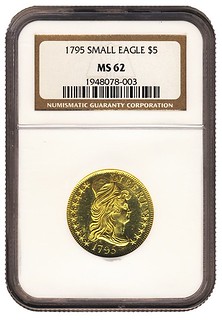 The story picks up on the aforementioned date of December 6, 2019. Around 4 p.m. Friday afternoon, longtime coin dealer Tom Phillips in Memphis called me to confirm that
my 1795 Half Eagle was still missing, for he had some news to tell me — it had been found and someone was attempting to sell it.
The story picks up on the aforementioned date of December 6, 2019. Around 4 p.m. Friday afternoon, longtime coin dealer Tom Phillips in Memphis called me to confirm that
my 1795 Half Eagle was still missing, for he had some news to tell me — it had been found and someone was attempting to sell it.
Earlier in the day, a young man and been in his shop and shown him a picture of the coin on his cell phone. Incredibly, the coin was still in the same NGC holder it was in when it went missing. The NGC certification number and photos matched exactly. Tom had discovered the coin was stolen by finding the press release issued by the Numismatic Crime Information Center in 2014.
Tom told the young man he would indeed be interested in purchasing the coin, and a meeting was arranged for later that day. After confirming with me that the coin was still missing, Tom contacted the Memphis Police Department. He explained the situation, and the police promised to send officers to his shop.
Around 5:30 p.m. Memphis time, the young man walked back into Tom's shop with my long-lost 1795 Half Eagle. Unfortunately, however, the Memphis Police weren't there yet. Tom bravely stalled the potential seller for about 30 minutes, hoping desperately for backup to arrive. Finally, six uniformed officers entered the shop, arrested the suspect and confiscated my coin.
Tom called me a few minutes later to tell me what had transpired. I was overcome with joy and excitement. Seldom does such a valuable coin surface after so long. I am deeply and eternally grateful to Tom Phillips and Doug Davis for their efforts in recovering my property.
The moral(s) of the story
For now, the coin remains in the evidence room of the Memphis Police Department. We have no idea how long the legal process will take to play out. One thing is for sure, it's much safer where it is now than wherever it has been for the past five years.
Reflecting on what transpired during this agonizing experience, there were many lessons learned that I would love to share with readers. Certainly this is a great example of the old adage the best lessons are learned the hard way!
1 When shipping any numismatic material be extremely careful, and do not skip safety precautions. Boxes should always be carefully wrapped with no indication there are valuables on the inside. Never mention coins or bullion in the "Ship to" line, even if the company name is Mid-American Rare Coin Galleries, Inc. or Numismatic Guaranty Corporation. Send the package to an individual only. Shipping coins can be tricky, and I would recommend you check with a professional for advice. Remember, unless instructed otherwise, FedEx will leave a package on a doorstep, and the insurance you purchased will be void.
2. The abovementioned episode clearly illustrates the advantage of having NGC-certified coins. The recovered coin was in an NGC holder with an NGC certification number, and this will make proving the coin is mine immeasurably easier.
3. Whenever shipping coins, you should be certain that you have a high-quality photograph of the coin. Luckily for me, NGC had a photo of the coin on file, and this would have been invaluable evidence if the coin had been broken out of the holder. I cannot overly state the importance of this advice. The NGC Photo Vision and PHOTO PROOF options are highly recommended for anyone with valuable coins.
To read the complete article, see:
Jeff Garrett: A Christmas Miracle (https://www.ngccoin.com/news/article/7982/)

A HISTORY OF MORMON MONEY
John Turner, Professor of American Religion at George Mason University published an article this week delving into the history of Mormon money. Here's an excerpt. -Editor

The Church of Jesus Christ of Latter-day Saints has allegedly amassed US$100 billion in purportedly charitable assets since 1997 without ever giving any money away – a possible breach of federal tax laws.
This estimate of the size of its investment vehicle known as Ensign Peak Advisors became public knowledge when David A. Nielsen, a former employee and a member of the church, blew the whistle.
From my vantage point as a historian of Mormonism, this news marks a new twist on an old story. For nearly two centuries, the church has conducted its finances in ways that defy the expectations Americans have for religious organizations.
Consider what happened in the summer of 1837, when the fledgling church teetered on the brink of collapse.
At the time, Joseph Smith and many church members lived in Kirtland, a small town in northeastern Ohio. The Smith family had moved there in the early 1830s, seeking a safer gathering place for church members in the face of persecution in New York state.
Smith and his followers began building a temple in Kirtland. The Saints dedicated their temple in 1836, but the project left Smith and others deep in debt. Like many communities in antebellum America, Mormon Kirtland was land-rich and cash-poor. A lack of hard currency hampered commerce.
Smith and his associates decided to start their own bank to solve their financial woes. The circulation of bank notes, they thought, would boost Kirtland's economic prospects and make it easier for church leaders to satisfy their creditors.
Lots of currency
The idea of Mormon leaders printing their own money wasn't as crazy as it sounds in 2019. The United States still lacked a uniform currency. A host of institutions of varying
integrity – chartered banks, unchartered banks, other businesses and even counterfeiting rings – issued notes whose acceptance depended on the confidence of citizens who might
accept or refuse them.
Mormon leaders bought engraving plates for printing bank notes and asked the Ohio state legislature to charter their bank. The Mormon proposal went nowhere in the legislature.
At this point, church leaders took a more fateful and dubious step.
They had collected money from investors and had already begun printing notes of the "Kirtland Safety Society Bank." Instead of shutting down the operation when the charter failed to come through, they doubled down. Worried about the legal risk of running an unchartered bank, church leaders altered the notes to read "anti-Banking-Co."
A brief boom
For a while, all went well. "Kirtland bills are as safe as gold," one church member wrote in January 1837. The town enjoyed a short-lived boom.
Soon, however, the anti-bank proved anything but safe. Non-Mormons questioned the society's ability to redeem its notes, and church leaders could not keep it afloat. The Kirtland Safety Society's struggles were not unusual. Scores of banks, including some of the nation's largest, failed in what became the Panic of 1837. Real estate speculators lost their fortunes, and workers lost their jobs.
What made Kirtland different was the bank's ownership. Many church members lost not only confidence in the society's banknotes, but faith in the prophet who had signed them.
The crisis divided the church. At one point that summer, church members wielding pistols and bowie knives fought with each other in the temple. Smith and one of his top associates were convicted of issuing banknotes without a charter and fined $1,000 each. They soon fled the courts and their creditors, taking refuge with fellow church members in Missouri.
After anti-Mormon mobs forced the Latter-day Saints out of Missouri and then Illinois, Smith's successor, Brigham Young, led thousands of church members to what became the Utah Territory.
See the complete article online for more. -Editor
To read the complete article, see:
Mormons and money: An unorthodox and messy history of church
finances (https://theconversation.com/mormons-and-money-an-unorthodox-and-messy-history-of-church-finances-129132)
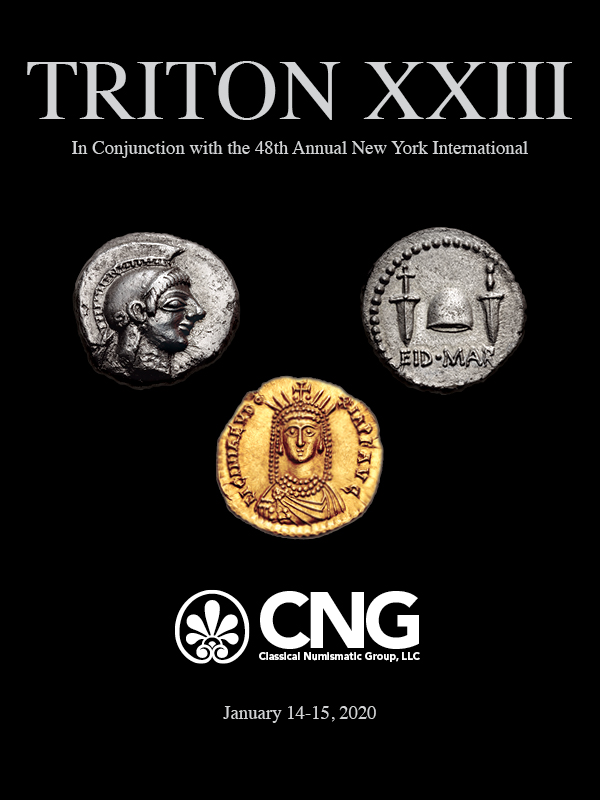
HERITAGE NYINC 2020 SALE HIGHLIGHTS
Here are a few highlights that caught my eye in the upcoming Heritage's New York International Numismatic Convention auction. -Editor
Lot 32190: Elizabeth I Gold Ship Ryal
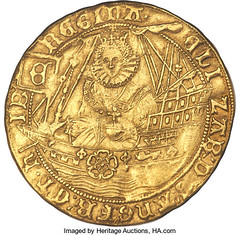
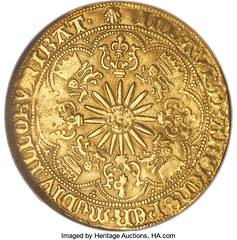
Elizabeth I (1558-1603) gold "Ship" Ryal of 15 Shillings ND (1584-1586) XF45 NGC, Tower mint, Escallop mm, Sixth issue, S-2530, N-2004. 7.52gm. Potentially the most coveted issue from Elizabeth's reign - the outstanding 'Ship' Ryal, produced solely for international trade in extremely limited numbers, a type missing from many of the most famous British collections. The Ryal was always a slightly controversial denomination, representing an attempt during Edward IV's first reign to simplify the interlocking gold types by producing a 'Half Sovereign' equivalent worth 10 Shillings. However, as the Noble of 6 Shillings 8 Pence was the standard by then, the Ryal was found unsuccessful and replaced shortly afterwards by the famous Angel type. Despite its initial unpopularity, the 10 Shilling Ryal reared its head once again in Henry VII's reign, and again in Mary's reign then worth 15 Shillings to match the 30 Shilling Sovereign. By Elizabeth's reign it was not considered to be a necessary denomination, and the present type was only produced for trade in the Netherlands, designed with charming medieval style imagery and Lombardic lettering.
Due to the quick abandonment of this denomination, only a handful of examples are known today and they always generate extreme excitement from collectors of British hammered gold when offered. This specimen is exemplary for issue, Elizabeth's portrait razor sharp with only localized areas of weakness to sunken areas of the flan and within the fourth quarter of the reverse. Dulled by tone and time to a pleasant honey-gold with subdued gleam at the highpoints; attractive, extremely rare and perhaps one of the only opportunities collectors will ever have to obtain an XF example of this celebrated denomination.
A busy design, but an important coin. -Editor
To read the complete lot description, see:
Great Britain: Elizabeth
I (1558-1603) gold "Ship" Ryal of 15 Shillings ND (1584-1586) XF45 NGC,..
(https://coins.ha.com/itm/great-britain/great-britain-elizabeth-i-1558-1603-gold-ship-ryal-of-15-shillings-nd-1584-1586-xf45-ngc-/a/3081-32190.s)
Lot 32221: 1817 George III Three Graces Crown
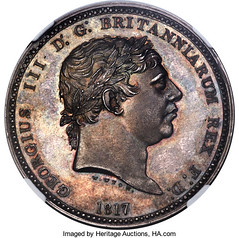
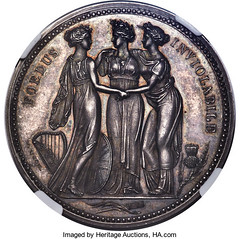
George III silver Proof Pattern "Three Graces" Crown 1817 PR65 NGC, KM-PnA77, L&S-152, ESC-2020 (R2). Plain edge. By William Wyon. Alongside the famous 1839 Una and the Lion 5 Pounds, the 1817 Three Graces Crown represents Wyon's most celebrated piece of medallic art. His portraiture of George was far finer than the contemporary work by Benedetto Pistrucci, but it is for its reverse design that this Pattern is so beloved; depicting England, Ireland and Scotland anthropomorphized as the Three Graces of Greek mythology wrapped in a circular embrace, these three Goddesses represent the United Kingdom. Its neoclassical beauty, its energy, sensitivity, realism, all embody a talent hitherto absent from British numismatics.
A great, classic coin. -Editor
To read the complete lot description, see:
Great Britain: George III silver
Proof Pattern "Three Graces" Crown 1817 PR65 NGC,...
(https://coins.ha.com/itm/great-britain/great-britain-george-iii-silver-proof-pattern-three-graces-crown-1817-pr65-ngc-/a/3081-32221.s)
Lot 32295: 1870 Japan Meiji Gold 20 Yen
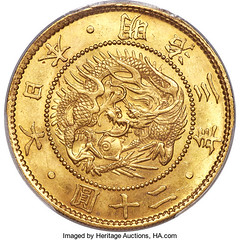

Meiji gold 20 Yen Year 3 (1870) MS65 PCGS, Osaka mint, KM-Y13, JNDA 01-1, J&V-L1. A stunning gem example of this scarce, and popular, first-year in the 20 Yen series. This superb piece has full, bright orange-golden luster, with sharply defined details and only minuscule marks that do not detract from the spectacular overall appearance. The only collectible date of the brief, large sized 20 Yen series. Rare in this exceptional condition, with fewer than 30 Mint State examples certified by NGC and PCGS combined and no examples graded finer than this piece across both grading services. The finest Mint State example we have seen. Ex. S. M. Damon Collection
Pretty piece. -Editor
To read the complete lot description, see:
Japan: Meiji gold 20 Yen Year 3 (1870) MS65 PCGS,...
(https://coins.ha.com/itm/japan/japan-meiji-gold-20-yen-year-3-1870-ms65-pcgs-/a/3081-32295.s)
Lot 32307: 1916 Mexico Revolutionary Gold 60 Pesos
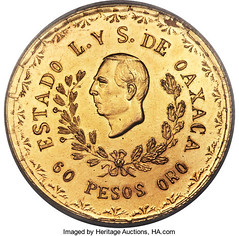
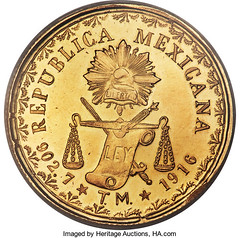
Oaxaca. Revolutionary gold 60 Pesos 1916 MS64+ PCGS, Oaxaca mint, KM755, Fr-174, GB-379. Reeded edge. An immense offering, one of Mexico's most iconic gold coinages and one whose popularity makes it almost impossible to obtain for the majority of collectors. What must certainly have been an enormous denomination for the period, with this being the largest struck during the Mexican Revolution, this type would have instantly stood out to its contemporaries, not least due to the relative shortage of gold coinage struck at the time, and its general crudeness when it was minted. Bordering on gem, the surfaces of this example appear perfect buttercup-yellow with velvety tone and little evidence of handling, every element of the strike exceptionally bold and subsequently untouched. Absolutely outstanding for its size, preservation, and aesthetic appeal.
Nice coin! -Editor
To read the complete lot description, see:
Mexico: Oaxaca. Revolutionary gold 60 Pesos 1916 MS64+
PCGS,... (https://coins.ha.com/itm/mexico/oaxaca/mexico-oaxaca-revolutionary-gold-60-pesos-1916-ms64-pcgs-/a/3081-32307.s)
Lot 32321: 1825 Russia: Alexander I Poltina 1/2 Rouble
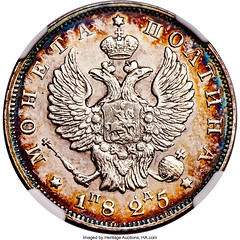
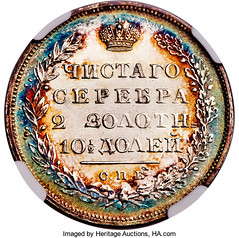
Alexander I Poltina (1/2 Rouble) 1825 C??-?? MS64? Prooflike NGC, St. Petersburg mint, KM-C123a, Bit-183, Sev-2868. Narrow crown variety. Obv. Crowned double-headed Imperial eagle, with upright wings, and date below. Rev. Crowned four-line inscription within wreath. The strike is bold and a thin band of russet patina encircles the peripheries on both the obverse and reverse. The fields are deeply mirrored and the devices heavily frosted, yielding nice cameo contrast. A conditionally very rare issue. Only three pieces have been certified by NGC, with none at PCGS, this being the finest certified example. Our research has found only six other pieces auctioned since 2005, the finest being an AU sold on April 13, 2013 by the Russian auction firm Coins and Medals (Auction 80, Lot 268), which brought $16,165. The other 5 all graded VF, or less. A stunning example and, by far, the finest we can reference.
To read the complete lot description, see:
Russia:
Alexander I Poltina (1/2 Rouble) 1825 C??-?? MS64? Prooflike NGC,...
(https://coins.ha.com/itm/russia/russia-alexander-i-poltina-1-2-rouble-1825-cand-1055-and-1041-and-1055-and-1044-ms64and-9733-prooflike-ngc-/a/3081-32321.s)

KüNKER'S ELIVE PREMIUM AUCTION 332
Here's the press release for Künker's upcoming eLive Premium Auction 332. Some great coins, tokens and medals here. -Editor
Special Collections in Künker's eLive Premium Auction 332
On 5 and 6 February 2020, an eLive Premium Auction will take place at Künker's virtual auction room combining several collections: Lower Saxony, House of Habsburg and Goetz medals. Furthermore, the taler treasure of Betzenstein will be auctioned off.
On 5 and 6 February 2020, several special collections will be on sale in the virtual auction room as of 6 pm. First, another part – almost 700 lots – of the Friedrich Popken Collection of coins and medals from the area of Lower Saxony will be auctioned off. A taler treasure from the Franconian city of Betzenstein comes next. Obviously, the find was officially reported to the competent authorities, which approved the sale. Then, about 50 Habsburg coins and medals will be auctioned off. This auction is rounded off by modern medals, a major part of the offer consists of a comprehensive collection of Goetz medals.
Coins and Medals from the Friedrich Popken Collection
The eLive Premium Auction starts with about 700 lots of coins, medals and tokens from the area of Lower Saxony on Wednesday, 5 February 2020 at 6 pm. This time, the sale will not
focus on the expensive rarities from the Friedrich Popken Collection. As every good collection of regional means of payment, this collection contained pieces struck on behalf of
the local governments, too. That's why everybody will have the possibility to acquire a piece from the Popken Collection for his or her own collection at this auction – after all,
the estimates start at 20 euros.
However, that doesn't mean that the lots are be less interesting – quite the opposite. At this point, we would like to give an impressive example: Friedrich Popken owned a rich collection of tokens from the city of Hildesheim. Among them is, for example, a series of six gate tokens made in 1609. These gate tokens provide us with insight into the daily life of the time before the Thirty Years' War.
Many cities used tokens to organise the payment of taxes and levies: Those who entered the city with vehicles or pack animals received such tokens when passing the city gate to prove that they had paid the fees for each animal. On the reverse, these tokens featured different numbers that referred to the number of animals. When the small caravan left the city, the watchman at the gate could check thanks to these tokens whether all fees had been paid and whether a merchant had sold one of his animals while he stayed in the city.
Other tokens authorised citizens to procure stones from the municipal quarries, limestone from the municipal lime pit and to feed their animals on common pasture.
This auction offers coins, medals or tokens of the following cities: Brunswick, Einbeck, Göttingen, Goslar, Hamelin, Hanover, Hildesheim, Lüneburg and Northeim.
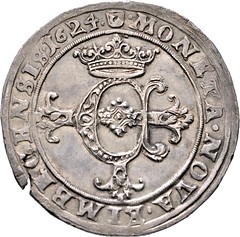
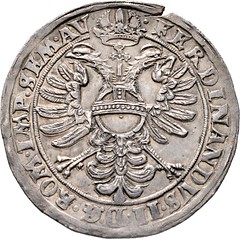
No. 2104– Einbeck. Reichstaler 1624. Very rare. Extremely fine. Estimate: 2,000 euros
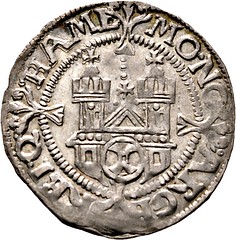

No. 2256– Hamelin. 1/16 talers (double schilling) 1608. Very rare, especially in this quality. Extremely fine. Estimate: 500 euros
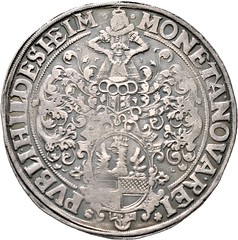

No. 2375– Hildesheim. Reichstaler 1628. Very fine. Estimate: 500 euros
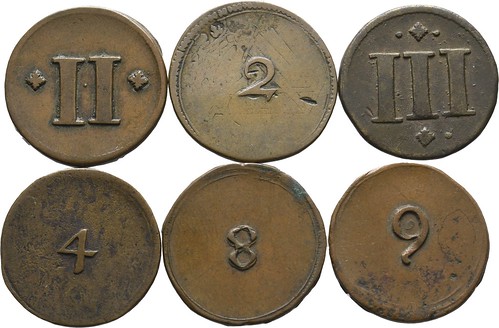
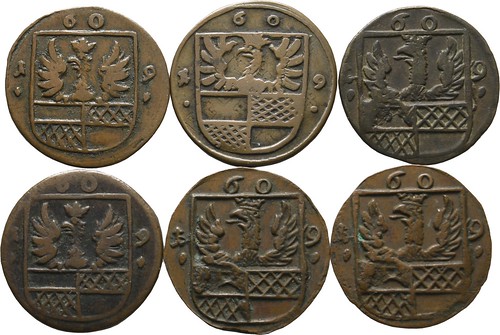
No. 2469– Hildesheim. Series of six gate tokens 1609. Most of them very fine. Estimate: 75 euros
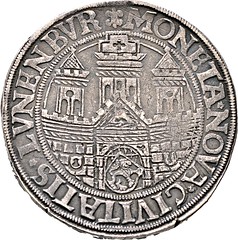
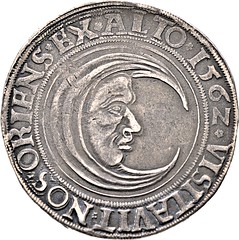
No. 2615– Lüneburg. Taler 1562. Very fine. Estimate: 500 euros
The Treasure of Betzenstein
At some point after 1626, an unknown person buried 123 talers and a half taler near the city of Betzenstein, which was then under the rule of Nuremberg. Was it a merchant passing
by? After all, Betzenstein was located at several important trade routes, like the one that led to Bohemia. Of course, it is also possible that it was a citizen trying to hide his
savings.
The treasure was probably buried in a bag made of leather or cloth. Some of the talers were made in remote regions like the Netherlands or Tuscany. However, most pieces are from the immediate surroundings: For example, the imperial city of Nuremberg is the issuer of about 50 pieces – almost 40% of the treasure. The fact that there is a span of 65 years between the minting of the oldest and the youngest piece tells us about how long coins were in circulation at that time.
Moreover, the youngest pieces provide us with the decisive indication as to the year in which the treasure was buried. No piece was minted after 1626.

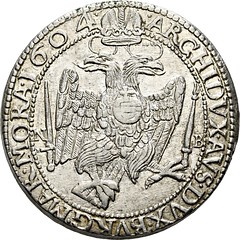
No. 2722 – Holy Roman Empire. Rudolf II. Reichstaler 1604, Baia Mare. Rare. Extremely fine. Estimate: 800 euros
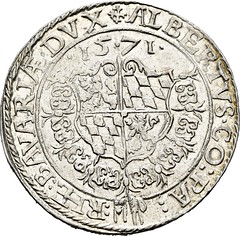
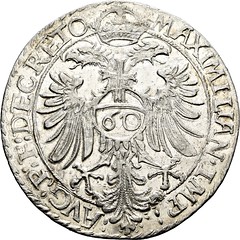
No. 2745– Bavaria. Albert V. Gulden taler (60 kreuzer) 1571, Munich. Rare. Extremely fine. Estimate: 1,000 euros
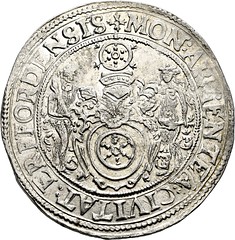
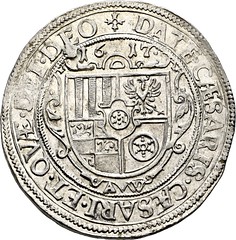
No. 2751– Erfurt. Reichstaler 1617. Rare. Extremely fine. Estimate: 1,500 euros
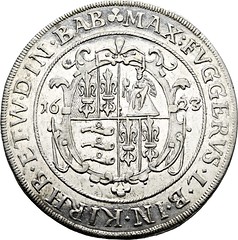
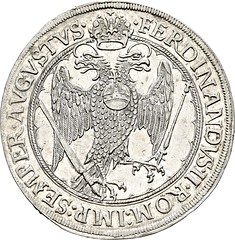
No. 2759 – Fugger-Babenhausen-Wellenburg. Maximilian II. Reichstaler 1623. Extremely fine to FDC. Estimate: 1,500 euros
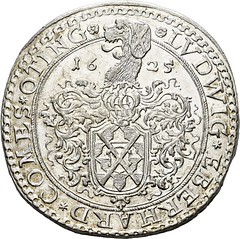

No. 2813– Oettingen. Ludwig Eberhard. Reichstaler 1625. Rare year. Extremely fine to FDC. Estimate: 1,500 euros
Coins of the Holy Roman Empire
If you are looking for coins of the Holy Roman Empire in excellent conditions at reasonable prices, you will find a lot of material in the "Special collection from the House of
Habsburg". The pieces originate from the time between Rudolf II and Leopold II. The specimens stem mainly from the mints of Hall, Vienna and Kremnica, but also from the mints of
Antwerp, Günzburg, Karlsburg, Kutná Hora, Milan, Baia Mare and Prague.
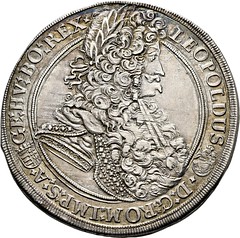
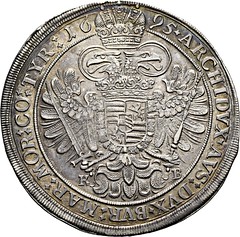
No. 2847 – HRE. Leopold I. Reichstaler 1695, Kremnica. Extremely fine. Estimate: 500 euros
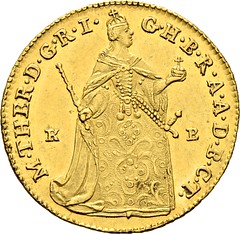
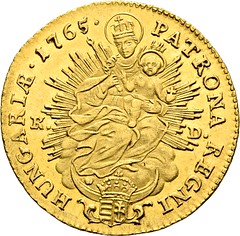
No. 2865 – HRE. Maria Theresa. Ducat 1765, Kremnica. Extremely fine to FDC. Estimate: 500 euros
Medals from all over the World
Medals are an insider tip among collectors. The production of medals is way more elaborate, however, their prices are significantly less expensive than coins of the same rarity.
Therefore, a glance at the catalogue is worth it, even though the above statement only applies to some of the pieces.
Over the last years, Goetz medals have developed into a popular collecting area. The eLive Premium Auction 332 features an extensive selection of these medals and focuses on the satirical medals of Karl Xaver Goetz (1875–1950). His form of propaganda can hardly be understood by today's observers; nevertheless, these medals are distinguished testimonies to the tense atmosphere in Germany in the time from the beginning of World War I to the end of World War II. After all, Goetz was first and foremost a businessman who produced whatever his clients were willing to buy. At the same time, he was an amazing artist as you can see by looking at the early portraits, for example the one made in 1905 commemorating the golden jubilee of the first Mass of the archbishop of München-Freising.
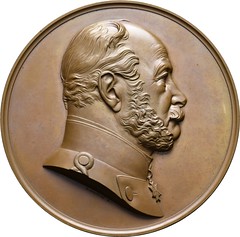

No. 2913– Prussia. Frederick William IV. Silver medal 1848 by K. Fischer commemorating his silver wedding anniversary with Elisabeth Ludovika, daughter of Maximilian I Joseph of Bavaria. Very rare. Beautiful patina. Almost FDC. Estimate: 250 euros
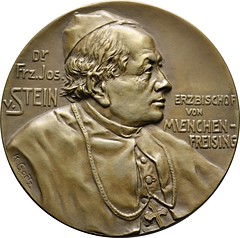
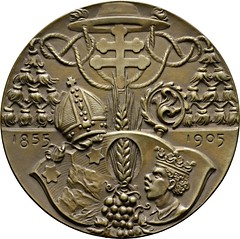
No. 2927 – Goetz Medals. Bronze cast medal 1905 commemorating the 50 year jubilee of the first Mass of Dr. Franz Joseph von Stein, Archbishop of München und Freising. Almost uncirculated. Estimate: 175 euros
The catalogue can be ordered at Künker, Nobbenburger Straße 4a, 49076 Osnabrück; phone: +49 541 / 96 20 20; fax: +49 541 / 96 20 222; or via Email: service@kuenker.de. You can also access the auction catalogue online at www.kuenker.de .
The viewing will take place from 2 to 25 January 2020 – only by prior appointment – in Osnabrück.
Additionally, the coins can be viewed at Estrel Hotel, Berlin on the following days:
Tuesday, 28 January 2020: 3 pm to 6 pm,
Wednesday, 29 January 2020: 10 am to 6 pm,
Thursday, 30 January 2020: 10 am to 6 pm.

NUMISMATIC NUGGETS: DECEMBER 29, 2019
Here's a selection of interesting or unusual items I came across in the marketplace this week. Nothing says "ooooh, shiny!" like some gold coins or medals. Tell us what you think of some of these. -Editor
c1811 Cambridge University Chancellor's Gold Medal
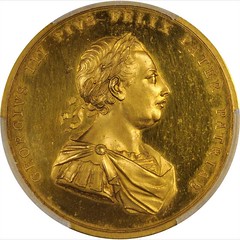
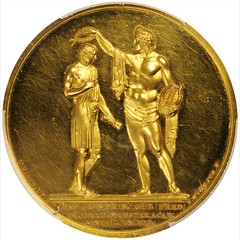
GREAT BRITAIN. Cambridge University Chancellor's Gold Medal, ND (ca. 1811). George III. PCGS SPECIMEN-62 Gold Shield.
52mm; 99.67 gms. BHM-Unlisted (though cf. 723 for rev.); Eimer-Unlisted. By J. Kirk (obv.) and N. Marchant & T. Wyon, Jr. (rev.). Struck in commemoration of the appointment of Prince William Frederick, the Duke of Gloucester and Edinburgh, as Chancellor of Cambridge University. Obverse: Laureate, draped, and armored bust right; Reverse: Apollo standing left, holding lyre and crowning scholar to left, holding scroll and placing hand over breast. Edge: JOHN GRAHAM A:B: CHRISTS COLL:. Sharing its obverse with an earlier chancellor's (the Duke of Grafton) medal, this later piece was struck under his successor ca. 1811 and utilizing an updated reverse design. In terms of rarity, seemingly on par with the Grafton piece, if not slightly SCARCER, especially with reflective fields, frosted devices, and warm honey golden toning as is featured on this piece. Graced with intricate detail on the obverse bust and reverse standing figures, though a few minor scuffs and contact marks are noted in the fields. Overall, an attractive and interesting personalized medal very seldom appearing in auction. Sold with original round display case. Incorrectly attributed as the Grafton piece (Eimer-728 and as ND [1768]) on the holder.
To read the complete lot description, see:
GREAT
BRITAIN. Cambridge University Chancellor's Gold Medal, ND (ca. 1811). George III. PCGS SPECIMEN-62 Gold Shield.
(https://auctions.stacksbowers.com/lots/view/3-L9SDF/great-britain-cambridge-university-chancellors-gold-medal-nd-ca-1811-george-iii-pcgs-specimen-62-gold-shield)
1890 Central American Union Pact Gold Medal
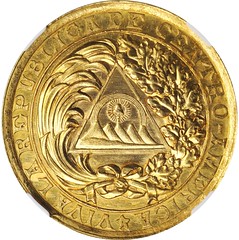
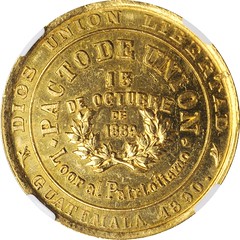
GUATEMALA. Central American Union Pact Gold & Silver Medals (2 Pieces), 1890. Both NGC MS-63.
Gold Medal. 32.30 gms. Some scattered marks and hairlines on the reverse, but presenting tremendous luster.
Interesting piece. I'm unfamiliar with the history behind it. -Editor
To read the complete lot description, see:
GUATEMALA. Central American
Union Pact Gold & Silver Medals (2 Pieces), 1890. Both NGC MS-63.
(https://auctions.stacksbowers.com/lots/view/3-L9Q6M/guatemala-central-american-union-pact-gold-silver-medals-2-pieces-1890-both-ngc-ms-63)
1987 Nobel Nominating Committee for Economics Gilt Silver Medal

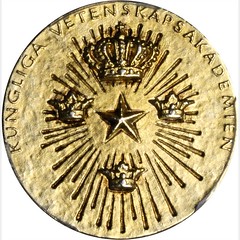
SWEDEN. Nobel Nominating Committee for Economics Gilt Silver Medal, 1987. PCGS SPECIMEN-66 Gold Shield.
Edge inscribed "N10", indicating the year 1987. Obverse: Head of Alfred Nobel left above crossed cornucopiae; Reverse: Swedish triple crowns with radiant star at center, large crown above. Textured surfaces throughout. Privy marks and date on edge. This medal in silver is bestowed to members of the Royal Academy of Science during the nominating process for laureates in Economics. Upon receipt of ten silver versions they may be traded for one example in gold. The textured surfaces are packed with their glittering mint luster and overall a very appealing example.
Cool item, and the next best thing to an actual Nobel prize medal. -Editor
To read the complete lot description, see:
SWEDEN. Nobel
Nominating Committee for Economics Gilt Silver Medal, 1987. PCGS SPECIMEN-66
(https://auctions.stacksbowers.com/lots/view/3-LA1G5/sweden-nobel-nominating-committee-for-economics-gilt-silver-medal-1987-pcgs-specimen-66-gold-shield)

ANCIENT COIN SERIES: RAVENNA
In a recent article on his CoinWeek Ancient Coin Series, Mike Markowitz takes a look at coins from the obscure Roman city of Ravenna. Here's a short excerpt - be sure to see the complete article online. -Editor
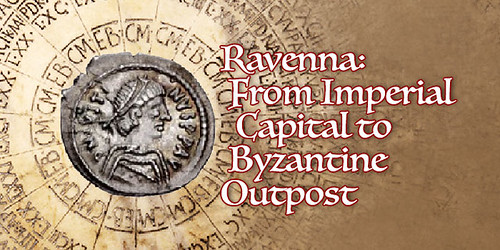
…[T]he sick promenade while the doctors lie abed, the baths freeze while the houses burn, the living are thirsty while the buried swim, thieves are vigilant while the authorities sleep, the clergy lend money while the Syrian merchants sing psalms… (Deliyannis, 50)
—Sidonius Apollinaris (c. 430-489 describing Ravenna as the imperial capital)
IN 402 CE, THE dim-witted 17-year-old emperor Honorius moved the capital of the Roman Empire in the West from the fortress city of Mediolanum (Milan) to the town of Ravenna on the Adriatic south of Venice. Surrounded by marshes, the city was hard to besiege but lacked a reliable supply of fresh water, prompting the quip by Bishop Sidonius: vivi sitiunt sepulti natant ("the living thirst while the buried swim"). Changes in the shoreline leave Ravenna inland today, but in the fifth century it was a major naval base. For centuries the town was an important mint, and the fascinating coinage of Ravenna documents a turbulent era of late Antiquity.
The coins fall into three periods: Late Western Roman (402 – 476), Ostrogothic (476 – 540) and Byzantine (540 – 751).
Western Roman
Honorius and Arcadius
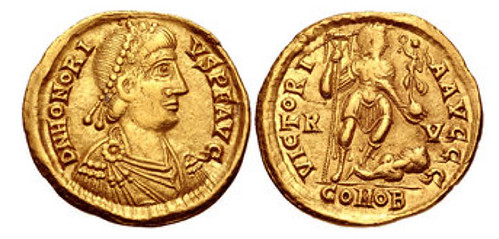
AV Solidus (20mm, 4.45 g, 12h). Ravenna mint. Struck 402-406 CE. Pearl-diademed, draped, and cuirassed bust right / Honorius standing right, spurning captive, holding labarum and Victory on globe; R-V//COMOB. RIC X 1287d
Early coins struck at Ravenna (c. 402 – 406) bear the stylized, portrait of the young emperor wearing the diadem; a pearl-studded headband that was an ancient emblem of royalty. The Latin inscription translates as "Our Lord Honorius, Faithful and Fortunate Emperor". On the reverse, a standing figure of this unmilitary emperor in full military attire holds a statuette of Victory, and a labarum (a kind of flagstaff) while trampling a barbarian captive. Ravenna's distinctive mint mark, R V, appears in the field. This type is quite common.
To read the complete article, see:
CoinWeek Ancient Coin Series – Ravenna: From Imperial
Capital to Byzantine Outpost (https://coinweek.com/ancient-coins/coinweek-ancient-coin-series-ravenna-from-imperial-capital-to-byzantine-outpost/)
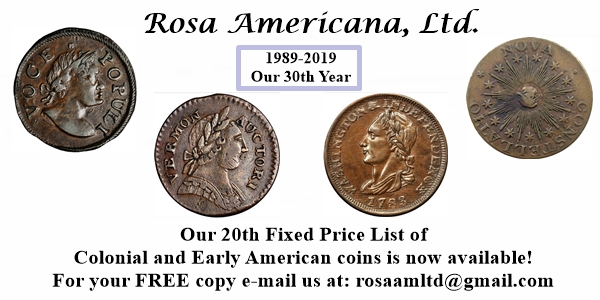
AGHLABID DYNASTY GOLD DINARS FOUND IN ISRAEL
Arthur Shippee forwarded this article from The Jerusalem Post. Thanks. -Editor
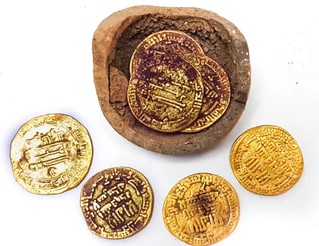 A Hanukkah present straight from the legendary One Thousand and One Nights has brightened the holiday of a group of Israeli archaeologists.
A Hanukkah present straight from the legendary One Thousand and One Nights has brightened the holiday of a group of Israeli archaeologists.
The Antiquities Authority announced Sunday that a juglet full of rare 1,200-year-old gold coins was discovered in an excavation in Yavne just before the festival. The site is being excavated by the IAA prior to the building of a new neighborhood in the city.
"I was in the middle of cataloging a large number of artifacts we found during the excavations when all of a sudden I heard shouts of joy," Liat Nadav-Ziv, codirector of the excavation said on behalf of the IAA. "I ran toward the shouting and saw Marc Molkondov, a veteran archaeologist of the Israel Antiquities Authority approaching me excitedly. We quickly followed him to the field where we were surprised at the sight of the treasure. This is without a doubt a unique and exciting find especially during the Hanukkah holiday."
As revealed by IAA coin expert Robert Kool, the coins date back to the early Abbasid Period, 9th century CE. The period marked the beginning of a golden age for the Muslim empire, with the Abbasid rulers acquiring international status and promoting art, science, commerce and industry. According to Kool, among the coins was a dinar from the reign of Caliph Harun al-Rashid (786-809 CE), whose court was the setting of many parts of the world-renowned One Thousand and One Nights– also known as Arabian Nights.
"The hoard also includes coins that are rarely found in Israel," Kool said. "These are gold dinars issued by the Aghlabid dynasty that ruled in North Africa, in the region of modern Tunisia, on behalf of the Abbasid Caliphate centered in Baghdad," he added. "Without a doubt this is a wonderful Hanukkah present for us."
Archaeologists excavating the site also found a large amount of pottery kilns used to produce jars, pots and bowls. The jug-let containing the gold coins was uncovered nearby, and the experts suggested it might have been the potter's "piggy-bank" where he had kept his personal savings. The kilns date back to the end of the Byzantine and beginning of the Early Islamic period (7th – 9th centuries CE).
To read the complete article, see:
Trove of 1,200-year-old ‘Arabian Nights' gold coins
uncovered in Israel (https://www.jpost.com/Israel-News/Culture/Trove-of-1200-year-old-Arabian-nights-gold-coins-uncovered-in-Israel-612471)
THE BOOK BAZARRE
18TH CENTURY COIN HOARD FOUND IN KRAKOW, POLAND
Dick Hanscom forwarded this Daily Mail article about a coin hoard found in Poland. Thanks. -Editor
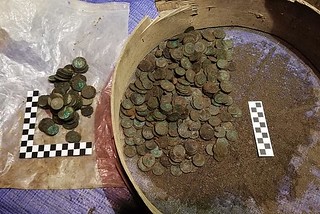 Builders have stumbled upon a treasure trove of 200-year-old coins worth nearly half a million pounds.
Builders have stumbled upon a treasure trove of 200-year-old coins worth nearly half a million pounds.
The 10,000 coins were discovered during renovation work in the historic city of Krakow in Poland.
Made of copper and minted in the time of the 18th century Polish king Stanislaw Poniatowski II, the rare copper coins had been stashed in the basement.
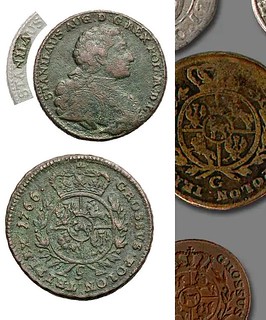 The coins were also hidden inside linen bags, which have since rotted away, when they were placed in the tenement building.
The coins were also hidden inside linen bags, which have since rotted away, when they were placed in the tenement building.
Copper coins from that period can be worth up to £40 each and experts estimate that the total value could therefore be as much as £400,000.
The coins have now been handed over to the Krakow Archaeological Museum, which will try to solve the mystery of how they got there and also preserve them.
To read the complete article, see:
Builders discover treasure trove of
200-year-old coins worth £400,000 while renovating a building in Poland
(https://www.dailymail.co.uk/news/article-7810439/Builders-discover-200-year-old-coins-worth-400-000-renovating-building-Poland.html)

THE DECADE AND DECIMALISATION
David Pickup submitted these thoughts on the decade pattern. Thanks! I added some images. -Editor
The Decade and Decimalisation
I was thinking about coins of the decade and discovered that "decade" was suggested as a denomination on a pattern florin, issued in the 1840s. We now use "decade" to mean ten years but it can be used to describe any unit of ten. There had been proposals for decimalisation in the early part of the Nineteen Century. A Decimal Association was founded in 1841 and the movement grew following the 1851 Great Exhibition and the desire to make international trade easier. There was a Royal Commission on Decimal Coinage (1856–1857) but the final report in 1859 from the Governor of the Bank of England rejected the idea as it had "few merits".
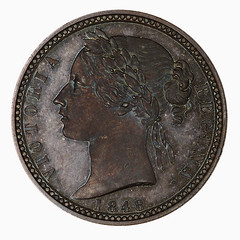

1848 Pattern Decade (from Museums Victoria)
In 1848 the Chief Engraver of the Royal Mint, William Wyon produced a pattern which defines itself as a tenth of a pound or 100 milles. The pattern was rejected along with the suggestion of ten decades or one thousand milles to a pound. The florin was introduced into circulation in Great Britain in 1849 as a first step towards decimal coinage.
The problem was that is easy to divide pounds shillings and pence, but it is difficult to use a decimal system and retain popular coins like the halfcrown, and sixpence. The idea of having a thousand milles to a pound was so the equivalent of a penny (five milles) could be divided into five farthings. No wonder it did not catch on!
The pattern is an attractive coin. The reverse was designed by a Scottish artist, mainly known as a painter, called William Dyce. It occasionally appears on the market. An example was sold by DNW in 2007 for £1,200.00


1848 Pattern Centum (from Heritage World Coin Signature Auction #3002)
To read the complete item descriptions, see:
Pattern Coin - Florin (Decade), Queen Victoria, Great Britain, 1848
(https://collections.museumvictoria.com.au/items/83481)
Great Britain: Victoria Pattern "Centum" 1848,...
(https://coins.ha.com/itm/great-britain/great-britain-victoria-pattern-centum-1848-/a/3002-21252.s)
1945 SILVER THREEPENCE SURFACES
A recent post on the NGC blog discusses an extremely rare British coin which recently surfaced and was submitted for grading and encapsulation. -Editor


The silver coin, the "rarest British circulating coin in 200 years," was one of 371,000 minted that year, all of which were supposed to have been destroyed.
The "rarest British circulating coin in 200 years" has been certified as genuine by Numismatic Guaranty Corporation® (NGC®), the world's largest third-party certification, grading and encapsulation service for rare and collectible coins.
The tiny silver coin — only the second known example — was not discovered in a buried hoard. The 1945 Silver Threepence was found in an ordinary Whitman folder, the type of cardboard booklet that young coin enthusiasts have filled with coin collections since the 1930s.
The coin had been removed from the Whitman folder and placed in a similarly humble plastic envelope, or flip, when it was brought to Baldwin's of St. James's, managing director Stephen Fenton said.
But it caused an immediate sensation even so.
"It was a coin I'd looked for for 50 years," Fenton said. "I regard this as the rarest British circulating coin for 200 years.
"You see lots of rare coins, but this is something I've always hoped to see someday. It's amazing proof that the rarest coins can emerge from the most humble of places."
Though the Nazis showered London with V-2 rockets in 1945, it was a more mundane reason that led to the 1945 Silver Threepence coin becoming almost extinct. The Silver Threepence had become unpopular because it was very small — a diameter of 16 mm (six-tenths of an inch) and a weight of 1.4 grams (five-hundredths of an ounce). A bigger, heavier, 12-sided nickel-brass threepence had been introduced in 1937 and was being minted every year.
The King George VI Silver Threepence was minted from 1937 to 1945, with a peak production of almost 8 million annually in 1940 and in 1941. But the wartime issues of 1942-45 all were shipped to the British West Indies. And the output of the coin's final year of 371,000 — apparently deemed redundant because of public acceptance of the 12-sided nickel-brass coin — was ordered to be melted down, its silver used in other mint products.
Every 1945 Silver Threepence was supposed to have been reduced to ingots, their inscriptions and profile of the king on the obverse and a St. George's cross over a Tudor rose on the reverse, destroyed.
But at least two coins escaped the crucible, and more of them might be sitting in jars or Whitman folders, waiting to be recognized for the rarities they are.
The new example is being offered at a Baldwin's of St. James's auction scheduled for March 2020, with an estimate of £15,000 to £25,000 ($20,000 to $30,000 USD), Fenton said.
How did it survive?
The owners, who Fenton declined to name, said they received the Whitman folder containing the coin from a relative who worked at the Royal Mint.
David Lange of NGC writes:
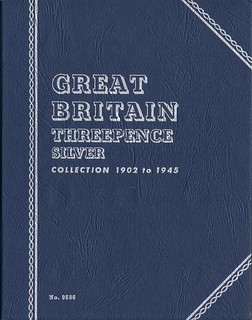 Reportedly, it was found within a Whitman blue folder for that coin series. I'm in the midst of scanning my collection of these folders for my book about Whitman
products, so I thought I'd send in a few images of the folder in question.
Reportedly, it was found within a Whitman blue folder for that coin series. I'm in the midst of scanning my collection of these folders for my book about Whitman
products, so I thought I'd send in a few images of the folder in question.
On the end flap of this title is a brief history of this coin series, in which it's noted that "The entire 1945 issue was melted by the mint and never released." Whitman's usual practice for rare coins was to include a removable plug reading RARE for that particular opening. When this folder was first issued in 1961, that step was overlooked for the 1945 threepence, but the next printing in 1965 did include a removable plug with the words NOT ISSUED.
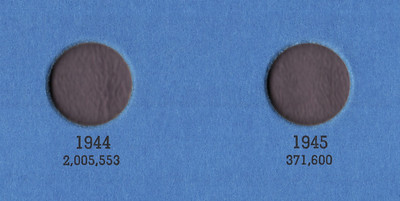
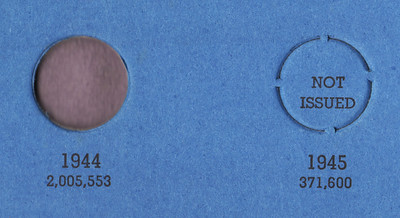
To read the complete article, see:
One of Only Two Known Surviving 1945 Silver Threepence Coins Surfaces (https://www.ngccoin.com/news/article/7956/)
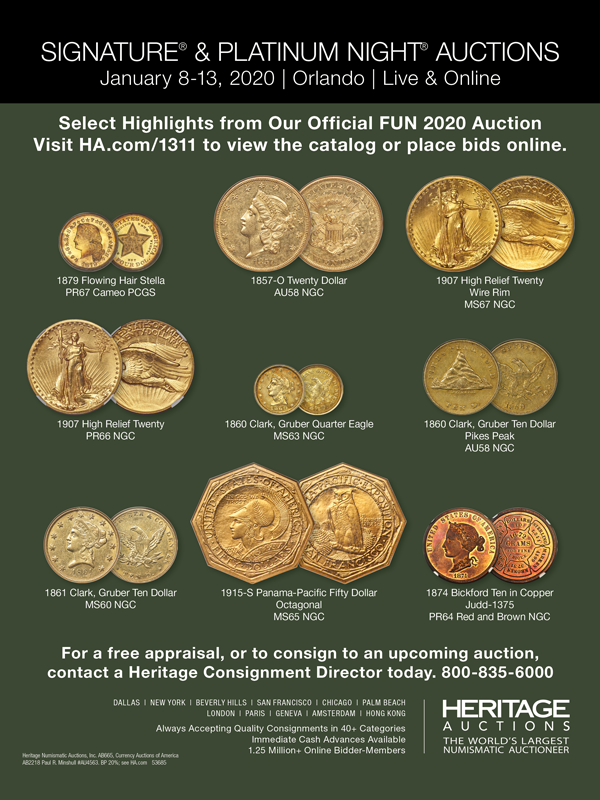
ALCOHOL-FUELED CAR MEDALS OF 1901-1902
A December 17, 2019 PCGS blog article by Jay Turner discusses two recently-certified gold medals relating to early alcohol-fueled automobiles. -Editor
The debate about environmental issues, natural resources, and technological improvements are more relevant than ever before. Yet, two French gold medals submitted for certification to the Shanghai, China, PCGS office are evidence of the technology that existed 120 years ago.
Using alcohol or ethanol as fuel is not new technology. Ethanol was isolated in the 12th century and was common by the 17th century as an easily burning fuel for lamps and cooking. Use of ethanol for internal combustion engines began as early as 1826. Many early cars were ethanol fueled due to its ease of access. However, the discovery of abundant oil and excessive taxes on alcohol in the United States allowed oil-based fuel or gasoline to undercut the use of ethanol fuel from becoming the dominate automotive fuel.
Nevertheless, before the dominance of oil-based energy, alcohol fuels seemed to be the dominate and preferred source of energy. In 1901, the French Ministry of Agriculture offered prizes for the best alcohol-fueled engines and household appliances. In 1902, the Paris Alcohol Exposition featured alcohol-powered cars and machinery, including lamps, stoves, heaters, irons, and even coffee roasters. The exhibit would travel Europe and eventually end up at the Jamestown, Virginia, Tricentennial events in the United States in 1907.

PCGS received two medals in October at the Shanghai grading event. A gold medal prize from the 1901 Ministry of Agriculture and a 1902 Paris Alcohol Exposition gold medal.
The 1901 medal was designed by Hubert Ponscarme and it features a female effigy of Liberty on the obverse with "REPUBLIQUE FRANCAISE" above. The reverse displays a caduceus intertwined with leaves, wheat and grapes. A centered rectangle serves as a plaque inscribed "CONCOURS D'APPAREILS A ALCOOL 1901 AUTOMOBILES" around the reverse "MINISTERE DE L'AGRICVLTVRE."
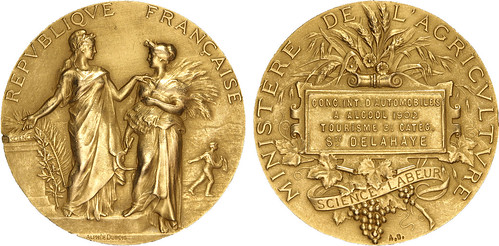
The 1902 medal was designed by Alphee Dubois and it features two women, one pointing to a book with the word "SCIENCE" on the spine, and another female figure holding a bundle of wheat, likely representing the Greek goddess Demeter. In the background, a boy is sowing seeds and written above is "REPUBLIQUE FRANCAISE." The reverse features a cluster of wheat, leaves, and grapes, with a central plaque. A ribbon scrolled below "SCIENCE LABEUR" and around the reverse is "MINISTERE DE L'AGRICULTURE." The plaque reads "CON. INT. D AUTOMOBILES A ALCOOL 1902 TOURISME 3. CATEG. Ste DELAHAYE." The 1902 medal was awarded to Delahaye, a French automotive manufacturing company founded by Emile Delahaye in 1894. The company would produce cars until it went out of business in 1954.
To read the complete article, see:
Ahead of its Time – The Alcohol-Fueled Car Medals of 1901-1902
(https://www.pcgs.com/news/alcohol-fueled-car-medals)

COMPANY SCRIP
The Paper Money Guaranty (PMG) blog published an uncredited article this month on company scrip. Here's an excerpt. -Editor
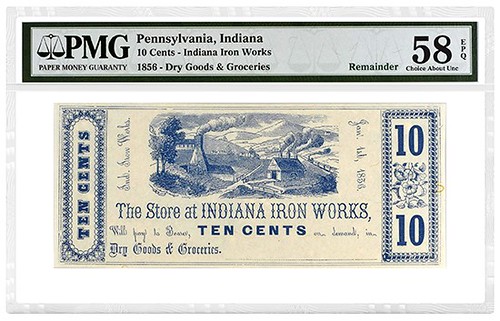
The promissory notes gave companies control over employees but also helped businesses and communities survive and thrive.
In the late 19th century, the U.S. and several other countries around the world went through a rapid phase of industrialization known as the Second Industrial Revolution or the Technological Revolution. Inventions like the telegraph, the lightbulb and the compressed-air brake greatly changed how people worked. Wages increased overall and so did the quality of life for many people.
However, the Technological Revolution also brought on new and dangerous working conditions and a continuation of unfair labor practices, holdovers from previous ages. Tycoons and magnates of the Industrial Revolution not only developed new methods of manufacturing but also sought new ways to control their labor force. One method was to issue company scrip.
Company scrip consists of promissory notes issued by a business as wages to its employees. Unlike government-backed notes, company scrip can only be redeemed for company goods or company services. The scrip was usually printed as sheets on rice paper. Often, the vignettes were pulled from catalogs and the originality and complexity of the notes depended on budget and whether anti-counterfeiting measures were deemed necessary. At its peak, scrip was accepted by some 20,000 company stores across North America. Companies distributed scrip for a number of reasons.
For one, it meant that employees gave a large portion, if not all, of their paycheck right back to their employer. A company could mark up prices on goods because employees had no other alternative — they couldn't take their scrip notes to any other stores. Company scrip also made it harder for employees to move, allowing the company to retain a workforce without raising wages or improving working conditions.
Company scrip wasn't all bad. It also allowed for the growth of industries in areas that were cash-poor and otherwise would not have had the chance to develop. It was given to workers who otherwise would have had no access to credit in cash-strapped regions and allowed companies to survive or even grow during economic slumps.
Company stores, by necessity, often became the social and economic epicenter of many mining and lumber towns. Because these industries were often in remote areas, cash was short and competition for supplies, and entertainment, were lacking. The goods you could buy at your company store ran the gamut from miners' lamps and safety shoes to bubble gum, candy and pop. Company stores also might include the town's barbershop, blacksmith and post office.
To read the complete article, see:
Company Scrip: The Tainted Lifeblood of 19th-century Remote Industrial Towns
(https://www.pmgnotes.com/news/article/7953/)
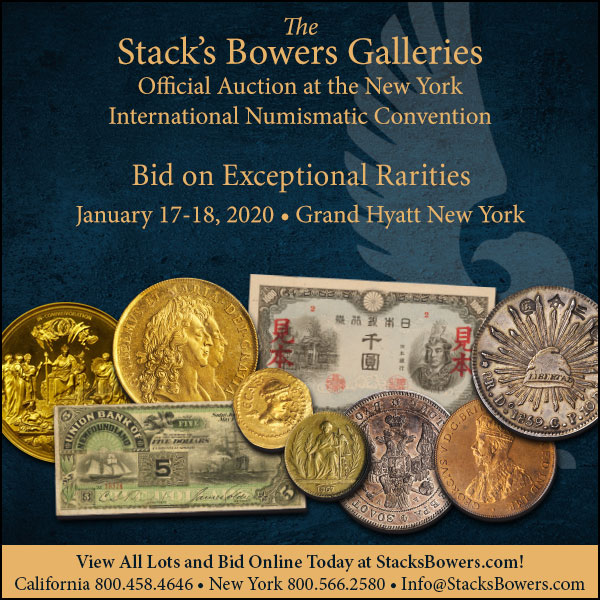
THE HISTORY OF OF HONG KONG BANKS
Another recent article on the PMG blog is a two-part piece on the history of Hong Kong banks -Editor
Hong Kong's government passed the Currency Ordinance of 1935, which took the Hong Kong dollar off the silver standard and switched it to being backed by pounds sterling. The system forced the banks to turn in their silver and be issued certificates of indebtedness. This provided a stability tool to evade fluctuations of the economy and a form of debt to manipulate in case of an emergency. For even more stability later in the 1980s, Hong Kong switched its dollar to be anchored by the U.S. dollar and still till this day has its Hong Kong dollar linked to the U.S. dollar. Due to the banking systems' stability for much of the region's history, banking and its currency have remained much the same since the 1800s. Long-lasting banks issuing their own currency made Hong Kong's currency unique.

The Hong Kong and Shanghai Banking Co. was created by a Scot named Thomas Sutherland in the 1860s. Sutherland modeled HSBC after Scottish banking, which is arguably one of the most stable free banking systems that ever existed. The Scottish foundation's conservative banking practices led to the stability of the bank and helped it exist for over 150 years. The bank even became the primary bank for the government of Hong Kong and China to acquire their debt to help pay for wars and public works. The stability and control over much of China's debt allowed the Hong Kong and Shanghai Banking Co. to virtually set the foreign exchange rate for China. As the 20th century progressed, HSBC acquired banks along the way and eventually formed the HSBC holdings group, which is the 7th largest bank in the world.
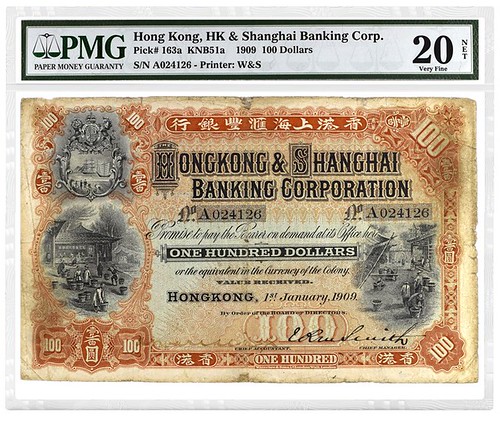
To read the complete article, see:
The History of Hong Kong's Banks and Currency
(https://www.pmgnotes.com/news/article/7848/History-of-Hong-Kong-Banks-and-its-Currency/)
The Long-lived Banks of Hong Kong — Part II
(https://www.pmgnotes.com/news/article/7919/The-History-of-Hong-Kongs-Banks-and-Currency-Part-II/)
BRITISH MUSEUM ACQUIRES 1,000-YEAR-OLD SEAL
The British Museum has acquired a rare 1,000-year-old seal. Not the swimming kind of seal - one used to impress a design onto wax seals on official documents. Researchers study these alongside coins and medals of the era - their manufacture has much in common. -Editor
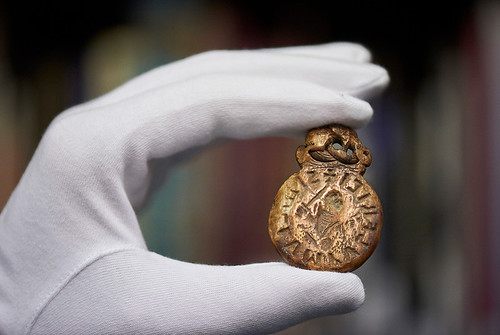
The British Museum announced it has acquired a very rare, walrus ivory seal matrix, which was made in England shortly before the invasion of William the Conqueror. Around 1,000 years old, it is one of only five examples known to survive, and this was the last one to have been in private hands. This exquisite piece of craftmanship now belongs to the nation where it can be studied and enjoyed for generations to come.
The seal matrix was used to seal documents to ensure authenticity and privacy, and is also thought to have been worn around the neck as a mark of status or as a way of identifying the wearer. The seal demonstrates how widespread documentary culture was at the time, with seals used for letters, land exchanges, grants from the king, and between monastic houses.
The seal bears the text SIGILLVM WULFRICI. Beyond this seal Wulfric leaves no trace. His seal is all that is known about him but the fact that he owned a seal implies he was of high status. It is very rare for evidence of a named person to survive from the pre-conquest period, and therefore this seal is an immensely valuable window into life in England before society was transformed after the invasion of the Normans. It is also an intricate piece of sculpture, featuring a sword and serpent devouring itself.
Lloyd de Beer, the Ferguson Curator of Medieval Britain and Europe at the British Museum said: "We're delighted to have this incredible object join the collection of the British Museum. These things are extremely rare, and it is an object that brings us close to a pivotal moment in history. Within a generation England would be completely transformed, and this object introduces us to one of its people."
To read the complete article, see:
British Museum acquires rare 1,000-year-old seal on third
attempt (https://artdaily.cc/news/119460/British-Museum-acquires-rare-1-000-year-old-seal-on-third-attempt#.XgIRD2RKhPY)
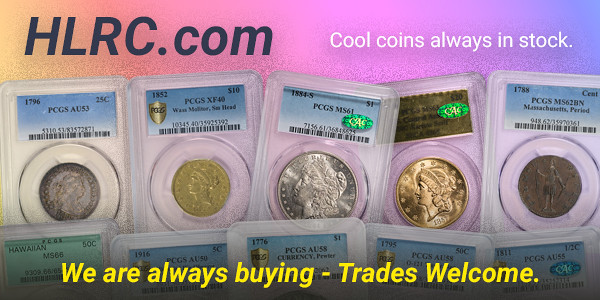
BBC ON THE ORIGINS OF THE DOLLAR SIGN
It's no scholarly footnoted article (so I have no idea where they got their facts from, and there's no mention of Eric P. Newman's great work), but this BBC article, one of its most read in 2019, discussed the history and development of the U.S. dollar sign. Thanks to Dick Hanscom for sending this along. Here's an excerpt. -Editor
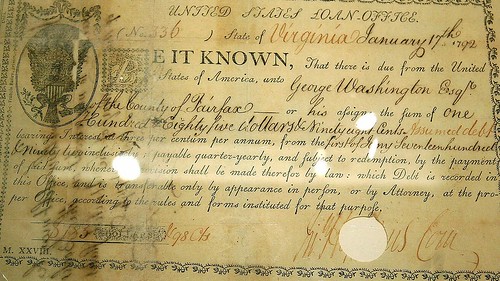
This vintage bond signed by former US president George Washington in 1792 contains the first use of the dollar sign on an American financial document
The dollar sign is among the world's most potent symbols, emblematic of far more than US currency.
It's shorthand for the American dream and all the consumerism and commodification that comes with it, signifying at once sunny aspiration, splashy greed and rampant capitalism. It's been co-opted by pop culture (think Ke$ha when she first started out, or any number of fast-fashion t-shirts) and borrowed by artists (Salvador Dali fashioned a moustache from it, Andy Warhol rendered it in acrylic and silkscreen, creating an iconic body of work that itself now sells for $$$).
It's used widely in computer coding and it provides money-mouth emoji with its dazed eyes and lolling tongue. Yet despite its polyglot ubiquity, the origins of the dollar sign remain far from clear, with competing theories touching on Bohemian coins, the Pillars of Hercules and harried merchants.
The British pound sign has a history going back 1,200 years, when it was first used by the Romans as an abbreviation for ‘libra pondo', the empire's basic unit of weight. As any amateur astrologer will tell you, libra means scales in Latin, and libra pondo literally translates as ‘a pound by weight'.
In Anglo-Saxon England, the pound became a unit of currency, equivalent to – surprise, surprise – a pound of silver. Vast riches, in other words. But along with the Roman name, the Anglo-Saxons borrowed the sign, an ornate letter ‘L'. The crossbar came along later, indicating that it's an abbreviation, and a cheque in London's Bank of England Museum shows that the pound sign had assumed its current form by 1661, even if it took a little longer for it to become universally adopted.

Warhol dollar sign artwork
See the full article for a set of competing theories on the dollar sign's origin, but also have a look at some of our earlier discussions on the topic, linked below. Also,
see this page from the site of Gly Davies, author of the 2002 book, A History of Money:
The Word "Dollar" and the Dollar Sign $
(https://projects.exeter.ac.uk/RDavies/arian/dollar.html)
Question: where is the illustrated 1792 George Washington bond? Is it part of a museum or private collection? And where exactly is the dollar sign the caption refers to? The bond is hard to read because writing on the back is bleeding through. -Editor
To read the complete article, see:
The curious origins of the dollar symbol
(https://www.bbc.com/worklife/article/20190528-the-curious-origin-of-the-symbol)
To read earlier E-Sylum articles, see:
THE ORIGINS OF THE DOLLAR SIGN (https://www.coinbooks.org/esylum_v10n08a12.html)
CAJORI ON THE ORIGIN OF THE DOLLAR SIGN (https://www.coinbooks.org/esylum_v19n18a18.html)
THE INCREDIBLE SHRINKING WALLET
As times change, so does the stuff we carry. This New York Times article discusses the changing size and shape of wallets in the digital age. Found via the December 24, 2019 issue (Volume V, Number 27) of News & Notes from the Society of Paper Money Collectors. -Editor
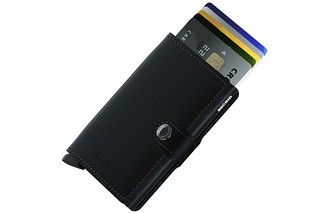 ... when Mr. Bray goes out at night, he takes just his ID, one credit card and a few business cards, tucked into a slim card case.
... when Mr. Bray goes out at night, he takes just his ID, one credit card and a few business cards, tucked into a slim card case.
"Simplify your life," he said. "Nine out of ten times, if you have a bi-fold wallet, you've got crap in there you don't need. You've got a ticket stub from three years ago."
This from a man who sells bi-fold wallets in four colors. But in recent years, the physical wallet's central role in our lives has been greatly reduced, as have the size of wallets themselves. As tech companies have introduced mobile apps like Apple Pay and Google Pay in an effort to make the smartphone into a digital wallet, "real" ones — long a fallback of the holiday gift season — are shrinking, or disappearing altogether. Some are becoming gizmos themselves, as if to seem more current: popping out cards with the press of a button and offering benefits like locating services or radio-frequency identification (RFID) blocking, intended to protect against credit-card or identity theft.
For men, the classic multi-pocketed model is losing popularity to card cases like the one Mr. Bray carries. They aren't much bigger than a credit card, and slip easily into a front pocket.
Mr. Capulong carries a leather card case by Veilance with only two pockets. "The seams are bonded, not stitched," he said. "So it's durable and minimalist. I keep maybe eight cards total and a $20 bill folded twice so it takes no space."
Augusto Gomez, who was behind the Prada counter in the men's arcade inside Bloomingdale's Manhattan flagship on a recent afternoon, said wallets still ranked as a popular gift, though there were no customers shopping for them at that moment.
For centuries, going all the way back to the introduction of paper currency in America in the late 1600s, the wallet has been a traveling bank vault and all-purpose file cabinet for men and women, a place to keep checks, cash and personal ephemera.
"I remember my dad's wallet," said Leland Grossman, a strategist for a Manhattan-based creative agency. "He had receipts, cards, pictures and a million things. That was my ethos originally. I kept a folded two-dollar bill. I had a Steve Jobs quote: ‘Stay hungry, stay foolish.'"
A 1998 episode of "Seinfeld" known to fans as "George's Exploding Wallet" satirized this tendency to overstuff. The George Costanza character is carrying a wallet so engorged with random items — Irish currency; a rewards card valid at any participating Orlando-area Exxon station — that he can barely close it.
"I need everything in there," George tells Jerry defensively at their favorite diner, before adding Sweet & Low packets to the jumble.
As if the physical wallet didn't have enough problems, there's now an accessory called the Wallet Slayer ($14.99): a sleeve that fits over your smartphone and holds three cards plus cash.
To read the complete article, see:
The Incredible Shrinking Wallet
(https://www.nytimes.com/2019/12/12/style/do-i-need-a-wallet.html)
As noted in an earlier Numismatic Diary article, my friend Steve Bishop has my vote for the most Costanza-esque wallet I've ever seen. It's big, but neat and tidy. -Editor

To read the earlier E-Sylum article, see:
WAYNE'S NUMISMATIC DIARY: FEBRUARY 26, 2017 (https://www.coinbooks.org/v20/esylum_v20n09a23.html)
LOOSE CHANGE: DECEMBER 29, 2019
Here are some additional items in the media this week that may be of interest. -Editor
Made From Recycled Electronics for 2020 Olympic Medals
A Greysheet blog article noted that the 2020 Olympic medals will be produced from materials recycled from discarded electronic devices. -Editor
 Japan has once again impressively shown how innovative it is and how innovative even the production of Olympic medals can be. The Olympic medals to be awarded during the
Olympic Games taking place in Tokyo next year will be made from recycled material from small electronic devices and mobile phones. According to the official "Tokyo 2020" website,
which also reports on details of the medal project, collection points have been set up throughout Japan to collect almost 79,000 tonnes of "material" in total, from about 6.1
million used mobile phones. Approx. 32 kg gold, 3,500 kg silver and 2,200 kg bronze were extracted from this material stock to produce the medals.
Japan has once again impressively shown how innovative it is and how innovative even the production of Olympic medals can be. The Olympic medals to be awarded during the
Olympic Games taking place in Tokyo next year will be made from recycled material from small electronic devices and mobile phones. According to the official "Tokyo 2020" website,
which also reports on details of the medal project, collection points have been set up throughout Japan to collect almost 79,000 tonnes of "material" in total, from about 6.1
million used mobile phones. Approx. 32 kg gold, 3,500 kg silver and 2,200 kg bronze were extracted from this material stock to produce the medals.
The medal design shows Nike on the front. She is depicted from the front, striding towards the viewer. The background is the Athens Panathinaiko Stadium; the Olympic Stadium of the first Olympic Games of modern times in 1896. It was built on the foundations of an ancient stadium and marble was used for the most part, which is unique in the world and makes it a sight even today. The five Olympic rings are arranged above Nike and the inscription "Games of the XXXII Olympiad Tokyo 2020" can be read at the top.
To read the complete article, see:
Japanese Mint to use recycle materials from electronic
devices on Olympic medals (http://blog.greysheet.com/japanese-mint-to-use-recycle-materials-from-electronic-devices-on-olympic-medals/)
To read the earlier E-Sylum article, see:
TOKYO 2020 OLYMPIC GAMES MEDAL DESIGN (https://www.coinbooks.org/v22/esylum_v22n50a21.html)
Original 1892 Olympic Manifesto Sold
On a related note, bibliophiles and researchers should appreciate this sale of the original 1892 Olympic manifesto document. From the Daily Mail. -Editor
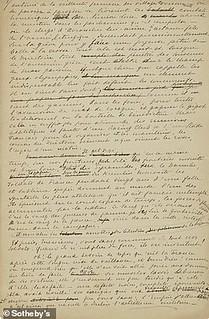 The original 127-year-old Olympic manifesto, which outlined the revival of the ancient Olympic games, has been auctioned off for $8.8 million, setting a new record for
sports memorabilia.
The original 127-year-old Olympic manifesto, which outlined the revival of the ancient Olympic games, has been auctioned off for $8.8 million, setting a new record for
sports memorabilia.
On Wednesday in Sotheby's New York salesroom, three international bidders vied for the French-language document over just 12 minutes before the winning offer was made. The buyer has not been identified.
The sale breaks a record for sports memorabilia set in June, when a New York Yankees jersey worn by Babe Ruth sold for $5.6 million.
Written in 1892 by Pierre de Coubertin, a French aristocrat and educator, the manifesto lays out the concept for the modern games, which he saw as a way of encouraging human progress and sportsmanship.
The document, which is 14 pages long and the only known copy of the manifesto, was delivered as a speech at Sorbonne University in Paris in 1892 on the fifth anniversary of the formation of the French Athletics Association.
After forming the International Olympic Committee in 1894, Coubertin's vision came to life in 1896 as the first modern Olympic games took place in Athens.
To read the complete article, see:
Original 1892 Olympic
manifesto, outlining the revival of the ancient games, sells for record $8.8million at auction - topping Babe Ruth's $5.6million Yankees jersey
(https://www.dailymail.co.uk/news/article-7810151/Original-1892-Olympic-manifesto-outlining-revival-ancient-games-sells-record-8-8million.html)
USPS Sued Over Religious-Themed Custom Stamps
In a lawsuit that may have implications for the "In God We Trust" motto on coins and paper money, the U.S. Postal Service is being sued over custom-designed stamps with a religious theme. -Editor
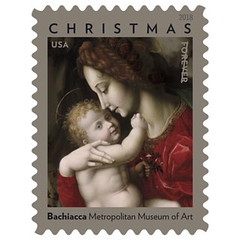 The law firm First Liberty is suing the United States Postal Service (USPS), alleging that a rule prohibiting Americans from requesting custom stamps with religious
content is unconstitutional.
The law firm First Liberty is suing the United States Postal Service (USPS), alleging that a rule prohibiting Americans from requesting custom stamps with religious
content is unconstitutional.
USPS has allowed private citizens to ask vendors contracting with the post office to provide custom-designed stamps -- but not if they contain religious or inappropriate content.
"USPS offers its own version of a religious stamp, but, ironically, it will not allow religious Americans to personalize stamps containing an expression of their own religious beliefs for their own use," Dys said. The USPS has been offering stamps of the Virgin Mary with baby Jesus.
To read the complete article, see:
USPS faces lawsuit for blocking private vendors from making stamps with religious content
(https://www.foxnews.com/faith-values/usps-lawsuit-stamps-religious-content)
BANK ROBBER TURNED SANTA
In the you-just-can't-make-this-stuff-up department, a bank robber in Colorado got the spirit of the season this week. -Editor
A Colorado Springs bank robbery got a Christmas spin.
Around noon on Monday, police said that an older man threatened a bank with the use of a weapon.
But he took a page from another man with a white beard, according to a witness.
"He robbed the bank, came out, threw the money all over the place,'" Dion Pascale told CNN affiliate KKTV. "He started throwing money out of the bag and then said, 'Merry Christmas!'"
Bystanders gathered the scattered cash and returned it to the bank teller as the suspect walked next door to the Starbucks and waited for the police, Pascale said.
To read the complete article, see:
Bank robbery suspect threw stolen money and wished everyone a 'Merry Christmas,' witness
said (https://www.cnn.com/2019/12/25/us/christmas-bank-robbery-trnd/index.html)

